Genghis Khan
Genghis Khan[note 4] (born Temüjin,[note 1] c. 1158 – August 18, 1227), was the founder and first Great Khan (Emperor) of the Mongol Empire, which became the largest contiguous empire in history after his death. He came to power by uniting many of the nomadic tribes of Northeast Asia. After founding the Empire and being proclaimed Genghis Khan (an honorary title ascending possibly from the Turkic "tengiz" — sea,[10] meaning "the oceanic, universal ruler"), he launched the Mongol invasions that conquered most of Eurasia, reaching as far west as Poland and the Levant in the Middle East. Campaigns initiated in his lifetime include those against the Qara Khitai, Khwarezmia, and the Western Xia and Jin dynasties, and raids into Medieval Georgia, the Kievan Rus', and Volga Bulgaria. These campaigns were often accompanied by large-scale massacres of the civilian populations, especially in the Khwarazmian- and Western Xia–controlled lands. Because of this brutality, which left millions dead, he is considered by many to have been a brutal ruler. By the end of his life, the Mongol Empire occupied a substantial portion of Central Asia and China. Due to his exceptional military successes, Genghis Khan is often considered to be the greatest conqueror of all time.[11]
| Genghis Khan | |||||||||||||
|---|---|---|---|---|---|---|---|---|---|---|---|---|---|
| |||||||||||||
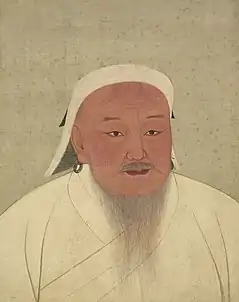 Genghis Khan as portrayed in a 14th-century Yuan era album; now located in the National Palace Museum, Taipei, Taiwan. The original version was in black and white; drawn by a Mongol painter under Kublai Khan supervision and commissioned in 1278. | |||||||||||||
| 1st Great Khan of the Mongol Empire | |||||||||||||
| Reign | Spring 1206 – August 18, 1227 | ||||||||||||
| Coronation | Spring 1206 in a Kurultai at the Onon River, Mongolia | ||||||||||||
| Successor | Ögedei Khan | ||||||||||||
| Born | Temüjin[note 1] c. 1155/1162[note 2] Khentii Mountains, Khamag Mongol | ||||||||||||
| Died | August 18, 1227[3] (aged approximately 65/72) Yinchuan, Western Xia | ||||||||||||
| Spouse |
others | ||||||||||||
| Issue |
| ||||||||||||
| |||||||||||||
| House | Borjigin | ||||||||||||
| Dynasty | Genghisid | ||||||||||||
| Father | Yesügei | ||||||||||||
| Mother | Hoelun | ||||||||||||
| Religion | Tengrism | ||||||||||||
Before Genghis Khan died, he assigned Ögedei Khan as his successor. Later his grandsons split his empire into khanates.[12] Genghis Khan died in 1227 after defeating the Western Xia. By his request, his body was buried in an unmarked grave somewhere in Mongolia.[13] His descendants extended the Mongol Empire across most of Eurasia by conquering or creating vassal states in all of modern-day China, Korea, the Caucasus, Central Asia, and substantial portions of Eastern Europe and Southwest Asia. Many of these invasions repeated the earlier large-scale slaughters of local populations. As a result, Genghis Khan and his empire have a fearsome reputation in local histories.[14]
Beyond his military accomplishments, Genghis Khan also advanced the Mongol Empire in other ways. He decreed the adoption of the Uyghur script as the Mongol Empire's writing system. He also practised meritocracy and encouraged religious tolerance in the Mongol Empire, unifying the nomadic tribes of Northeast Asia. Present-day Mongolians regard him as the founding father of Mongolia.[15] He is also credited with bringing the Silk Road under one cohesive political environment. This brought relatively easy communication and trade between Northeast Asia, Muslim Southwest Asia, and Christian Europe, expanding the cultural horizons of all three areas.[16]
Early life
Lineage
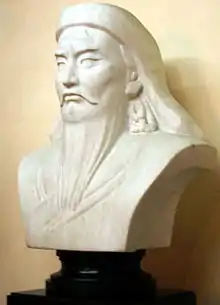
Genghis Khan was related on his father's side to Khabul Khan, Ambaghai, and Hotula Khan, who had headed the Khamag Mongol confederation and were descendants of Bodonchar Munkhag (c. 900). When the Jurchen Jin dynasty switched support from the Mongols to the Tatars in 1161, they destroyed Khabul Khan.[17][18]
Genghis Khan's father, Yesügei (leader of the Kiyat-Borjigin[10] clan and nephew to Ambaghai and Hotula Khan), emerged as the head of the ruling Mongol clan. This position was contested by the rival Tayichi'ud clan, who descended directly from Ambaghai. When the Tatars grew too powerful after 1161, the Jin switched their support from the Tatars to the Keraites.[19][20]
Birth

Little is known about Genghis Khan's early life, due to the lack of contemporary written records. The few sources that give insight into this period often contradict.
Genghis Khan's birth name, Temüjin, was derived from the Mongol word temür meaning "of iron", while jin denotes agency.[21] Temüjin thus means "blacksmith".[22]
Genghis Khan was probably born in 1162[note 2] in Delüün Boldog, near the mountain Burkhan Khaldun and the rivers Onon and Kherlen in modern-day northern Mongolia, close to the current capital Ulaanbaatar. The Secret History of the Mongols reports that Temüjin was born grasping a blood clot in his fist, a traditional sign that he was destined to become a great leader. He was the first son of Hoelun, second wife of his father Yesügei, who was a Kiyad chief prominent in the Khamag Mongol confederation and an ally of Toghrul of the Keraite tribe.[23] Temüjin was the first son of his mother Hoelun. According to the Secret History, Temüjin was named after the Tatar chief Temüjin-üge whom his father had just captured.
Yesukhei's clan was Borjigin (Боржигин), and Hoelun was from the Olkhunut sub-lineage of the Khongirad tribe.[24][25] Like other tribes, they were nomads. Temüjin's noble background made it easier for him to solicit help from and eventually consolidate the other Mongol tribes.[26]
Early life and family
.jpg.webp)
Temüjin had three brothers Hasar, Hachiun, and Temüge, one sister Temülen, and two half-brothers Begter and Belgutei. Like many of the nomads of Mongolia, Temüjin's early life was difficult.[27] His father arranged a marriage for him and delivered him at age nine to the family of his future wife Börte of the tribe Khongirad. Temüjin was to live there serving the head of the household Dai Setsen until the marriageable age of 12.[28][29]
While heading home, his father ran into the neighboring Tatars, who had long been Mongol enemies, and they offered him food that poisoned him. Upon learning this, Temüjin returned home to claim his father's position as chief. But the tribe refused this and abandoned the family, leaving it without protection.[30]
For the next several years, the family lived in poverty, surviving mostly on wild fruits, ox carcasses, marmots, and other small game killed by Temüjin and his brothers. Temüjin's older half-brother Begter began to exercise power as the eldest male in the family and would eventually have the right to claim Hoelun (who was not his own mother) as a wife.[31] Temüjin's resentment erupted during one hunting excursion when Temüjin and his brother Khasar killed Begter.[31]
In a raid around 1177, Temüjin was captured by his father's former allies, the Tayichi'ud, and enslaved, reportedly with a cangue (a sort of portable stocks). With the help of a sympathetic guard, he escaped from the ger (yurt) at night by hiding in a river crevice.[32] The escape earned Temüjin a reputation. Soon, Jelme and Bo'orchu joined forces with him. They and the guard's son Chilaun eventually became generals of Genghis Khan.[33]
At this time, none of the tribal confederations of Mongolia were united politically, and arranged marriages were often used to solidify temporary alliances. Temüjin grew up observing the tough political climate, which included tribal warfare, thievery, raids, corruption, and revenge between confederations, compounded by interference from abroad, such as from China to the south.[34] Temüjin's mother Hoelun taught him many lessons, especially the need for strong alliances to ensure stability in Mongolia.[35]
Wives, concubines, and children
As was common for powerful Mongol men, Genghis Khan had many wives and concubines.[36][37] He frequently acquired wives and concubines from empires and societies that he had conquered, these women were often princesses or queens that were taken captive or gifted to him.[37] Genghis Khan gave several of his high-status wives their own ordos or camps to live in and manage. Each camp also contained junior wives, concubines, and even children. It was the job of the Kheshig (Mongol imperial guard) to protect the yurts of Genghis Khan's wives. The guards had to pay particular attention to the individual yurt and camp in which Genghis Khan slept, which could change every night as he visited different wives.[38] When Genghis Khan set out on his military conquests, he usually took one wife with him and left the rest of his wives (and concubines) to manage the empire in his absence.[39]
Börte
The marriage between Börte and Genghis Khan (then known as Temüjin) was arranged by her father and Yesügei, Temüjin's father, when she was 10 and he was 9 years old.[40][41] Temüjin stayed with her and her family until he was called back to take care of his mother and younger siblings, due to the poisoning of Yesügei by Tatar nomads.[42] In 1178, about 7 years later, Temüjin traveled downstream along the Kelüren River to find Börte. When Börte's father saw that Temüjin had returned to marry Börte, he had the pair "united as man and wife". With the permission of her father, Temüjin took Börte and her mother to live in his family yurt. Börte's dowry was a fine black sable jacket.[43][44]

Soon after the marriage between them took place, the Three Merkits attacked their family camp at dawn and kidnapped Börte.[45] She was given to one of their warriors as a spoil of war. Temüjin was deeply distressed by the abduction of his wife and remarked that his "bed was made empty" and his "breast was torn apart".[46] Temüjin rescued her several months later with the aid of his allies Wang Khan and Jamukha.[47] Many scholars describe this event as one of the key crossroads in Temüjin's life, which moved him along the path towards becoming a conqueror.
“As the pillaging and plundering went on, Temüjin moved among the people that were hurriedly escaping, calling, ‘Börte, Börte!’ And so he came upon her, for Lady Börte was among those fleeing people. She heard the voice of Temüjin and, recognizing it, she got off the cart and came running towards him. Although it was still night, Lady Börte and Qo’aqčin both recognized Temüjin’s reins and tether and grabbed them. It was moonlight; he looked at them, recognized Lady Börte, and they fell into each other’s arms.” -The Secret History of the Mongols[46]
Börte was held captive for eight months, and gave birth to Jochi soon after she was rescued. This left doubt as to who the father of the child was, because her captor took her as a "wife" and could have possibly impregnated her.[45] Despite this, Temüjin let Jochi remain in the family and claimed him as his own son. Börte had three more sons, Chagatai (1183–1242), Ögedei (1186–1241), and Tolui (1191–1232). Temüjin had many other children with other wives, but they were excluded from the succession, only Börte's sons could be considered to be his heirs. Börte was also the mother to several daughters, Kua Ujin Bekhi, Alakhai Bekhi, Alaltun, Checheikhen, Tümelün, and Tolai. However, the poor survival of Mongol records means it is unclear whether she gave birth to all of them.[48]
Yesugen
During his military campaign against the Tatars, Temüjin fell in love with Yesugen and took her in as a wife. She was the daughter of a Tatar leader named Yeke Cheren that Temüjin's army had killed during battle. After the military campaign against the Tatars was over, Yesugen, one of the survivors went to Temüjin, who slept with her. According to the Secret History of the Mongols, while they were having sex Yesugen asked Temüjin to treat her well and to not discard her. When Temüjin seemed to agree with this, Yesugen recommended that he also marry her sister Yesui.[49]
Being loved by him, Yisügen Qatun said, ‘If it pleases the Qa’an, he will take care of me, regarding me as a human being and a person worth keeping. But my elder sister, who is called Yisüi, is superior to me: she is indeed fit for a ruler.’
— The Secret History of The Mongols[50]
Both the Tatar sisters, Yesugen and Yesui, became a part of Temüjin's principal wives and were given their own camps to manage. Temüjin also took a third woman from the Tatars, an unknown concubine.[51]
Yesui
At the recommendation of her sister Yesugen, Temüjin had his men track down and kidnap Yesui. When she was brought to Temüjin, he found her every bit as pleasing as promised and so he married her.[52] The other wives, mothers, sisters and daughters of the Tatars had been parceled out and given to Mongol men.[51] The Tatar sisters, Yesugen and Yesui, were two of Genghis Khan's most influential wives. Genghis Khan took Yesui with him when he set out on his final expedition against the Tangut empire.[53]
Khulan
Khulan entered Mongol history when her father, the Merkit leader Dayir Usan, surrendered to Temüjin in the winter of 1203–04 and gave her to him. But at least according to the Secret History of the Mongols, Khulan and her father were detained by Naya'a, one of Temüjin's officers, who was apparently trying to protect them from Mongol soldiers who were nearby. After they arrived three days later than expected, Temüjin suspected that Naya'a was motivated by his carnal feelings towards Khulan to help her and her father. While Temüjin was interrogating Naya'a, Khulan spoke up in his defense and invited Temüjin to have sex with her and inspect her virginity personally, which pleased him.[54]
In the end Temüjin accepted Dayir Usan's surrender and Khulan as his new wife. However, Dayir Usan later retracted his surrender but he and his subjects were eventually subdued, his possessions plundered, and he himself killed. Temüjin continued to carry out military campaigns against the Merkits until their final dispersal in 1218. Khulan was able to achieve meaningful status as one of Temüjin's wives and managed one of the large wifely camps, in which other wives, concubines, children and animals lived. She gave birth to a son named Gelejian, who went on to participate with Börte's sons in their father's military campaigns.[55]
Möge Khatun
Möge Khatun was a concubine of Genghis Khan and she later became a wife of his son Ögedei Khan.[56] The Persian historian Ata-Malik Juvayni records that Möge Khatun "was given to Chinggis Khan by a chief of the Bakrin tribe, and he loved her very much." Ögedei favored her as well and she accompanied him on his hunting expeditions.[57] She is not recorded as having any children.[58]
Juerbiesu
Juerbiesu was an empress of Qara Khitai, Mongol Empire, and Naiman. She was a renowned beauty on the plains. She was originally a favored concubine of Inanch Bilge khan and after his death, she became the consort of his son Tayang Khan. Since Tayang Khan was a useless ruler, Juerbiesu was in control of almost all power in Naiman politics.[59]
She had a daughter named Princess Hunhu (渾忽公主) with Yelü Zhilugu, the ruler of Liao. After Genghis Khan destroyed the Naiman tribe and Tayang Khan was killed, Juerbiesu made several offensive remarks regarding Mongols, describing their clothes as dirty and smelly. Yet, she abruptly rescinded her claims and visited Genghis Khan's tent alone. He questioned her about the remarks but was immediately attracted to her beauty. After spending the night with him, Juerbiesu promised to serve him well and he took her as one of his empresses. Her status was only inferior to Khulan and Borte.
Ibaqa Beki
Ibaqa was the eldest daughter of the Kerait leader Jakha Gambhu, who allied with Genghis Khan to defeat the Naimans in 1204. As part of the alliance, Ibaqa was given to Genghis Khan as a wife.[60] She was the sister of Begtütmish, who married Genghis Khan's son Jochi, and Sorghaghtani Beki, who married Genghis Khan's son Tolui.[60][61] After about two years of childless marriage, Genghis Khan abruptly divorced Ibaqa and gave her to the general Jürchedei, a member of the Uru'ut clan and who had killed Jakha Gambhu after the latter turned against Genghis Khan.[62][63] The exact reason for this remarriage is unknown: According to The Secret History of the Mongols, Genghis Khan gave Ibaqa to Jürchedei as a reward for his service in wounding Nilga Senggum in 1203 and, later, in killing Jakha Gambhu.[62] Conversely, Rashid al-Din in Jami' al-tawarikh claims that Genghis Khan divorced Ibaqa due to a nightmare in which God commanded him to give her away immediately, and Jürchedei happened to be guarding the tent.[62] Regardless of the rationale, Genghis Khan allowed Ibaqa to keep her title as Khatun even in her remarriage, and asked that she would leave him a token of her dowry by which he could remember her.[62][63] The sources also agree that Ibaqa was quite wealthy.[64]
Uniting the Mongol confederations
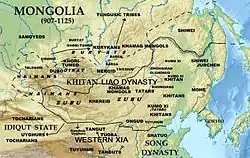
In the early 12th century, the Central Asian plateau north of China was divided into several prominent tribal confederations, including Naimans, Merkits, Tatars, Khamag Mongols, and Keraites, that were often unfriendly towards each other, as evidenced by random raids, revenge attacks, and plundering.
Early attempts at power
Temüjin began his ascent to power by offering himself as an ally (or, according to other sources, a vassal) to his father's anda (sworn brother or blood brother) Toghrul, who was Khan of the Keraites, and is better known by the Chinese title "Wang Khan", which the Jurchen Jin dynasty granted him in 1197. This relationship was first reinforced when Börte was captured by the Merkits. Temüjin turned to Toghrul for support, and Toghrul offered 20,000 of his Keraite warriors and suggested that Temüjin involve his childhood friend Jamukha, who had himself become Khan of his own tribe, the Jadaran.[65]
Although the campaign rescued Börte and utterly defeated the Merkits, it also paved the way for the split between Temüjin and Jamukha. Before this, they were blood brothers (anda) vowing to remain eternally faithful.
Rift with Jamukha and defeat at Dalan Balzhut
As Jamukha and Temüjin drifted apart in their friendship, each began consolidating power, and they became rivals. Jamukha supported the traditional Mongolian aristocracy, while Temüjin followed a meritocratic method, and attracted a broader range and lower class of followers.[66] Following his earlier defeat of the Merkits, and a proclamation by the shaman Kokochu that the Eternal Blue Sky had set aside the world for Temüjin, Temüjin began rising to power.[67] In 1186, Temüjin was elected khan of the Mongols. Threatened by this rise, Jamukha attacked Temujin in 1187 with an army of 30,000 troops. Temüjin gathered his followers to defend against the attack, but was decisively beaten in the Battle of Dalan Balzhut.[67][68] However, Jamukha horrified and alienated potential followers by boiling 70 young male captives alive in cauldrons.[69] Toghrul, as Temüjin's patron, was exiled to the Qara Khitai.[70] The life of Temüjin for the next 10 years is unclear, as historical records are mostly silent on that period.[70]
Return to power
Around the year 1197, the Jin initiated an attack against their formal vassal, the Tatars, with help from the Keraites and Mongols. Temüjin commanded part of this attack, and after victory, he and Toghrul were restored by the Jin to positions of power.[70] The Jin bestowed Toghrul with the honorable title of Ong Khan, and Temüjin with a lesser title of j'aut quri.[71]
Around 1200, the main rivals of the Mongol confederation (traditionally the "Mongols") were the Naimans to the west, the Merkits to the north, the Tanguts to the south, and the Jin to the east.

In his rule and his conquest of rival tribes, Temüjin broke with Mongol tradition in a few crucial ways. He delegated authority based on merit and loyalty, rather than family ties.[72] As an incentive for absolute obedience and the Yassa code of law, Temüjin promised civilians and soldiers wealth from future war spoils. When he defeated rival tribes, he did not drive away their soldiers and abandon their civilians. Instead, he took the conquered tribe under his protection and integrated its members into his own tribe. He would even have his mother adopt orphans from the conquered tribe, bringing them into his family. These political innovations inspired great loyalty among the conquered people, making Temüjin stronger with each victory.[72]
Rift with Toghrul
Senggum, son of Toghrul (Wang Khan), envied Genghis Khan's growing power and affinity with his father. He allegedly planned to assassinate Genghis Khan. Although Toghrul was allegedly saved on multiple occasions by Genghis Khan, he gave in to his son[73] and became uncooperative with Genghis Khan. Genghis Khan learned of Senggum's intentions and eventually defeated him and his loyalists.
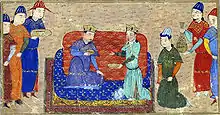
One of the later ruptures between Genghis Khan and Toghrul was Toghrul's refusal to give his daughter in marriage to Jochi, Genghis Khan's first son. This was disrespectful in Mongolian culture and led to a war. Toghrul allied with Jamukha, who already opposed Genghis Khan's forces. However, the dispute between Toghrul and Jamukha, plus the desertion of a number of their allies to Genghis Khan, led to Toghrul's defeat. Jamukha escaped during the conflict. This defeat was a catalyst for the fall and eventual dissolution of the Keraite tribe.[74]
After conquering his way steadily through the Alchi Tatars, Keraites, and Uhaz Merkits and acquiring at least one wife each time, Temüjin turned to the next threat on the steppe, the Turkic Naimans under the leadership of Tayang Khan with whom Jamukha and his followers took refuge.[55] The Naimans did not surrender, although enough sectors again voluntarily sided with Genghis Khan.
In 1201, a khuruldai elected Jamukha as Gür Khan, "universal ruler", a title used by the rulers of the Qara Khitai. Jamukha's assumption of this title was the final breach with Genghis Khan, and Jamukha formed a coalition of tribes to oppose him. Before the conflict, several generals abandoned Jamukha, including Subutai, Jelme's well-known younger brother. After several battles, Jamukha was turned over to Genghis Khan by his own men in 1206.
According to the Secret History, Genghis Khan again offered his friendship to Jamukha. Genghis Khan had killed the men who betrayed Jamukha, stating that he did not want disloyal men in his army. Jamukha refused the offer, saying that there can only be one sun in the sky, and he asked for a noble death. The custom was to die without spilling blood, specifically by having one's back broken. Jamukha requested this form of death, although he was known to have boiled his opponents' generals alive.
Sole ruler of the Mongol plains (1206)
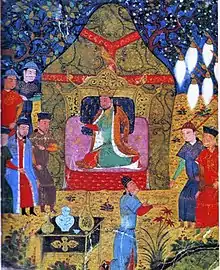
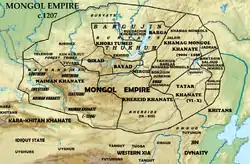
The part of the Merkit clan that sided with the Naimans were defeated by Subutai, who was by then a member of Genghis Khan's personal guard and later became one of Genghis Khan's most successful commanders. The Naimans' defeat left Genghis Khan as the sole ruler of the Mongol steppe – all the prominent confederations fell or united under his Mongol confederation.
Accounts of Genghis Khan's life are marked by claims of a series of betrayals and conspiracies. These include rifts with his early allies such as Jamukha (who also wanted to be a ruler of Mongol tribes) and Wang Khan (his and his father's ally), his son Jochi, and problems with the most important shaman, who allegedly tried to drive a wedge between him and his loyal brother Khasar. His military strategies showed a deep interest in gathering intelligence and understanding the motivations of his rivals, exemplified by his extensive spy network and Yam route systems. He seemed to be a quick student, adopting new technologies and ideas that he encountered, such as siege warfare from the Chinese. He was also ruthless, demonstrated by his tactic of measuring against the linchpin, used against the tribes led by Jamukha.
As a result, by 1206, Genghis Khan had managed to unite or subdue the Merkits, Naimans, Mongols, Keraites, Tatars, Uyghurs, and other disparate smaller tribes under his rule. This was a monumental feat. It resulted in peace between previously warring tribes, and a single political and military force. The union became known as the Mongols. At a Khuruldai, a council of Mongol chiefs, Genghis Khan was acknowledged as Khan of the consolidated tribes and took the new title "Genghis Khan". The title Khagan was conferred posthumously by his son and successor Ögedei who took the title for himself (as he was also to be posthumously declared the founder of the Yuan dynasty).
According to the Secret History of the Mongols, the chieftains of the conquered tribes pledged to Genghis Khan by proclaiming:
"We will make you Khan; you shall ride at our head, against our foes. We will throw ourselves like lightning on your enemies. We will bring you their finest women and girls, their rich tents like palaces."[75][76]
Religion
Genghis Khan was a Tengrist, but was religiously tolerant and interested in learning philosophical and moral lessons from other religions. He consulted Buddhist monks (including the Zen monk Haiyun), Muslims, Christian missionaries, and the Taoist monk Qiu Chuji.[77]
According to the Fozu Lidai Tongzai written by Nian Chang (b. 1282) Genghis Khan's viceroy Muqali was pacifying Shanxi in 1219, the homeland of Zen Buddhist monk Haiyun (海雲, 1203-1257), when one of Muqali's Chinese generals, impressed with Haiyun and his master Zhongguan's demeanor, recommended them to Muqali. Muqali then reported on the two to Genghis Khan who issued the following decree on their behalf: "They truly are men who pray to Heaven. I should like to support them with clothes and food and make them chiefs. I'm planning on gathering many of this kind of people. While praying to Heaven, they should not have difficulties imposed on them. To forbid any mistreatment, they will be authorized to act as darqan (possessor of immunity)." Genghis Khan had already met Haiyun in 1214 and been impressed by his reply refusing to grow his hair in the Mongol hairstyle and allowed him to keep his head shaven.[78] After the death of his master Zhongguan in 1220, Haiyun became the head of the Chan (Chinese Zen) school during Genghis Khan's rule and was repeatedly recognized as the chief monk in Chinese Buddhism by subsequent Khans until 1257 when he was succeeded as chief monk by another Chan master Xueting Fuyu the Mongol-appointed abbot of Shaolin monastery.[79]
Genghis Khan summoned and met the Daoist master Qiu Chuji (1148–1227) in Afghanistan in 1222. He thanked Qiu Chuji for accepting his invitation and asked if Qiu Chuji had brought the medicine of immortality with him. Qiu Chuji said there was no such thing as a medicine of immortality but that life can be extended through abstinence. Genghis Khan appreciated his honest reply and asked Qiu Chuji who it is that calls him eternal heavenly man, he himself or others.[80] After Qiu Chuji replied that others call him by that name Genghis Khan decreed that from thenceforth Qiu Chuji should be called "Immortal" and appointed him master of all monks in China, noting that heaven had sent Qiu Chuji to him. Qiu Chuji died in Beijing the same year as Genghis Khan and his shrine became the White Cloud Temple. Following Khans continued appointing Daoist masters of the Quanzhen School at White Cloud Temple. The Daoists lost their privilege in 1258 after the Great Debate organized by Genghis Khan's grandson Möngke Khan when Chinese Buddhists (led by the Mongol-appointed abbot or shaolim zhanglao of Shaolin monastery), Confucians and Tibetan Buddhists allied against the Daoists. Kublai Khan was appointed to preside over this debate (in Shangdu/Xanadu, the third meeting after two debates in Karakorum in 1255 and 1256) in which 700 dignitaries were present. Kublai Khan had already met Haiyun in 1242 and been swayed towards Buddhism.[81]
Genghis Khan's decree exempting Daoists (xiansheng), Buddhists (toyin), Christians (erke'üd) and Muslims (dashmad) from tax duties were continued by his successors until the end of the Yuan dynasty in 1368. All the decrees use the same formula and state that Genghis Khan first gave the decree of exemption.[82] Kublai Khan's 1261 decree in Mongolian appointing the elder of the Shaolin monastery uses the same formula and states "Činggis qan-u jrlg-tur toyid erkegü:d šingšingü:d dašmad aliba alba gubčiri ülü üjen tngri-yi jalbariju bidan-a irüge:r ögün atugai keme:gsen jrlg-un yosuga:r...ene Šaolim janglau-da bariju yabuga:i jrlg ögbei" (According to the decree of Genghis Khan which says may the Buddhists, Christians, Daoists and Muslims be exempt from all taxation and may they pray to God and continue offering us blessings...I have given this decree to the Shaolin elder to carry it). According to Juvaini, Genghis Khan allowed religious freedom to Muslims during his conquest of Khwarezmia "permitting the recitation of the takbir and the azan". However, Rashid-al-Din states there were occasions when Genghis Khan forbade Halal butchering. Kublai Khan revived the decree in 1280 after Muslims refused to eat at a banquet. He forbade Halal butchering and circumcision. The decree of Kublai Khan was revoked after a decade. Genghis Khan met Wahid-ud-Din in Afghanistan in 1221 and asked him if the prophet Muhammad predicted a Mongol conqueror. He was initially pleased with Wahid-ud-Din but then dismissed him from his service saying "I used to consider you a wise and prudent man, but from this speech of yours, it has become evident to me that you do not possess complete understanding and that your comprehension is but small".[83]
Military campaigns
Western Xia Dynasty
During the 1206 political rise of Genghis Khan, the Mongol Empire created by Genghis Khan and his allies shared its western borders with the Western Xia dynasty of the Tanguts. To the east and south was the Jin dynasty, founded by the Manchurian Jurchens, who ruled northern China as well as being the traditional overlords of the Mongolian tribes for centuries.
.jpeg.webp)
.jpeg.webp)
Genghis Khan organized his people, army, and his state to first prepare for war with Western Xia, or Xi Xia, which was close to the Mongolian lands. He correctly believed that the more powerful young ruler of the Jin dynasty would not come to the aid of Xi Xia. When the Tanguts requested help from the Jin dynasty, they were refused.[73] Despite initial difficulties in capturing its well-defended cities, Genghis Khan managed to force the emperor of Xi Xia to submit to vassal status.
Jin dynasty
In 1211, after the conquest of Western Xia, Genghis Khan planned again to conquer the Jin dynasty. Wanyan Jiujin, the field commander of the Jin army, made a tactical mistake in not attacking the Mongols at the first opportunity. Instead, the Jin commander sent a messenger, Ming'an, to the Mongol side, who defected and told the Mongols that the Jin army was waiting on the other side of the pass. At this engagement fought at Yehuling, the Mongols massacred hundreds of thousands of Jin troops. In 1215, Genghis besieged, captured, and sacked the Jin capital of Zhongdu (modern-day Beijing). This forced the Jin ruler, Emperor Xuanzong, to move his capital south to Kaifeng, abandoning the northern half of his empire to the Mongols. Between 1232 and 1233, Kaifeng fell to the Mongols under the reign of Genghis's third son, Ögedei Khan. The Jin dynasty collapsed in 1234, after the siege of Caizhou.
Qara Khitai
Kuchlug, the deposed Khan of the Naiman confederation that Temüjin defeated and folded into his Mongol Empire, fled west and usurped the khanate of Qara Khitai (also known as the Western Liao, as it was originally established as remnants of the Liao dynasty). Genghis Khan decided to conquer the Qara Khitai and defeat Kuchlug, possibly to take him out of power. By this time the Mongol army was exhausted from ten years of continuous campaigning in China against the Western Xia and Jin dynasty. Therefore, Genghis sent only two tumen (20,000 soldiers) against Kuchlug, under his younger general, Jebe, known as "The Arrow".
With such a small force, the invading Mongols were forced to change strategies and resort to inciting internal revolt among Kuchlug's supporters, leaving the Qara Khitai more vulnerable to Mongol conquest. As a result, Kuchlug's army was defeated west of Kashgar. Kuchlug fled again, but was soon hunted down by Jebe's army and executed. By 1218, as a result of the defeat of Qara Khitai, the Mongol Empire and its control extended as far west as Lake Balkhash, which bordered Khwarazmia, a Muslim state that reached the Caspian Sea to the west and Persian Gulf and the Arabian Sea to the south.[84]
Khwarazmian Empire
In the early 13th century, the Khwarazmian dynasty was governed by Shah Ala ad-Din Muhammad. Genghis Khan saw the potential advantage in Khwarazmia as a commercial trading partner using the Silk Road, and he initially sent a 500-man caravan to establish official trade ties with the empire. Genghis Khan and his family and commanders invested in the caravan gold, silver, silk, various kinds of textiles and fabrics and pelts to trade with the Muslim traders in the Khwarazmian lands.[85] However, Inalchuq, the governor of the Khwarazmian city of Otrar, attacked the caravan, claiming that the caravan contained spies and therefore was a conspiracy against Khwarazmia. The situation became further complicated because the governor later refused to make repayments for the looting of the caravans and hand over the perpetrators. Genghis Khan then sent a second group of three ambassadors (two Mongols and a Muslim) to meet the Shah himself, instead of the governor Inalchuq. The Shah had all the men shaved and the Muslim beheaded and sent his head back with the two remaining ambassadors. Outraged, Genghis Khan planned one of his largest invasion campaigns by organizing together around 100,000 soldiers (10 tumens), his most capable generals and some of his sons. He left a commander and number of troops in China, designated his successors to be his family members and likely appointed Ögedei to be his immediate successor and then went out to Khwarazmia.
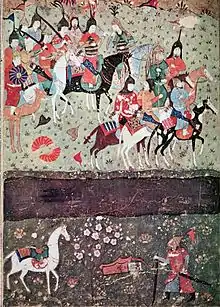
The Mongol army under Genghis Khan, generals and his sons crossed the Tien Shan mountains by entering the area controlled by the Khwarazmian Empire. After compiling intelligence from many sources Genghis Khan carefully prepared his army, which was divided into three groups. His son Jochi led the first division into the northeast of Khwarazmia. The second division under Jebe marched secretly to the southeast part of Khwarazmia to form, with the first division, a pincer attack on Samarkand. The third division under Genghis Khan and Tolui marched to the northwest and attacked Khwarazmia from that direction.
The Shah's army was split by diverse internecine feuds and by the Shah's decision to divide his army into small groups concentrated in various cities. This fragmentation was decisive in Khwarazmia's defeats, as it allowed the Mongols, although exhausted from the long journey, to immediately set about defeating small fractions of the Khwarazmian forces instead of facing a unified defense. The Mongol army quickly seized the town of Otrar, relying on superior strategy and tactics. Genghis Khan ordered the wholesale massacre of many of the civilians, enslaved the rest of the population and executed Inalchuq by pouring molten silver into his ears and eyes, as retribution for his actions. Near the end of the battle the Shah fled rather than surrender. Genghis Khan ordered Subutai and Jebe to hunt him down, giving them 20,000 men and two years to do this. The Shah died under mysterious circumstances on a small island within his empire.
The Mongols' conquest, even by their own standards, was brutal. After the capital Samarkand fell, the capital was moved to Bukhara by the remaining men, while Genghis Khan ordered two of his generals and their forces to completely destroy the remnants of the Khwarazmian Empire, including not only royal buildings, but entire towns, populations, and even vast swaths of farmland.
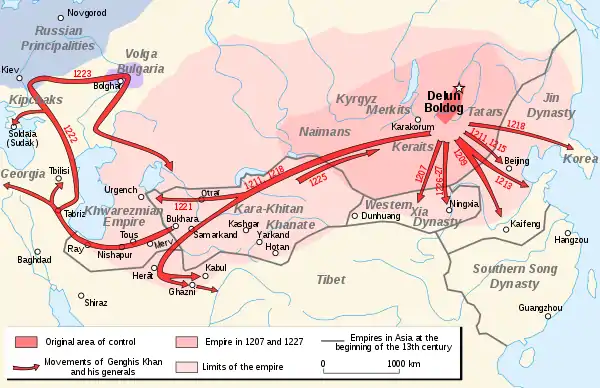
The Mongols attacked Samarkand using captured enemies as body shields. After several days only a few remaining soldiers, loyal supporters of the Shah, held out in the citadel. After the fortress fell, Genghis supposedly reneged on his surrender terms and executed every soldier that had taken arms against him at Samarkand. The people of Samarkand were ordered to evacuate and assemble in a plain outside the city, where they were killed and pyramids of severed heads raised as a symbol of victory.[86] Ata-Malik Juvayni, a high official in the service of the Mongol empire, wrote that in Termez, on the Oxus, "all the people, both men and women, were driven out onto the plain, and divided in accordance with their usual custom, then they were all slain".[86]
The city of Bukhara was not heavily fortified, with a moat and a single wall, and the citadel typical of Khwarazmian cities. The city leaders opened the gates to the Mongols, though a unit of Turkish defenders held the city's citadel for another twelve days. Survivors from the citadel were executed, artisans and craftsmen were sent back to Mongolia, young men who had not fought were drafted into the Mongolian army and the rest of the population was sent into slavery. As the Mongol soldiers looted the city, a fire broke out, razing most of the city to the ground.[87] Genghis Khan had the city's surviving population assemble in the main mosque of the town, where he declared that he was the flail of God, sent to punish them for their sins.
Meanwhile, the wealthy trading city of Urgench was still in the hands of Khwarazmian forces. The assault on Urgench proved to be the most difficult battle of the Mongol invasion and the city fell only after the defenders put up a stout defense, fighting block for block. Mongolian casualties were higher than normal, due to the unaccustomed difficulty of adapting Mongolian tactics to city fighting.
As usual, the artisans were sent back to Mongolia, young women and children were given to the Mongol soldiers as slaves, and the rest of the population was massacred. The Persian scholar Juvayni states that 50,000 Mongol soldiers were given the task of executing twenty-four Urgench citizens each, which would mean that 1.2 million people were killed. The sacking of Urgench is considered one of the bloodiest massacres in human history.
In the meantime, Genghis Khan selected his third son Ögedei as his successor before his army set out, and specified that subsequent Khans should be his direct descendants. Genghis Khan had left Muqali, one of his most trusted generals, in command of all Mongol forces in Jin China while he battled the Khwarezmid Empire to the west.
Georgia, Crimea, Kievan Rus and Volga Bulgaria
After the defeat of the Khwarazmian Empire in 1220, Genghis Khan gathered his forces in Persia and Armenia to return to the Mongolian steppes. Under the suggestion of Subutai, the Mongol army was split into two forces. Genghis Khan led the main army on a raid through Afghanistan and northern India towards Mongolia, while another 20,000 (two tumen) contingent marched through the Caucasus and into Russia under generals Jebe and Subutai. They pushed deep into Armenia and Azerbaijan. The Mongols defeated the kingdom of Georgia, sacked the Genoese trade-fortress of Caffa in Crimea and overwintered near the Black Sea. Heading home, Subutai's forces attacked the allied forces of the Cuman–Kipchaks and the poorly coordinated 80,000 Kievan Rus' troops led by Mstislav the Bold of Halych and Mstislav III of Kiev who went out to stop the Mongols' actions in the area. Subutai sent emissaries to the Slavic princes calling for a separate peace, but the emissaries were executed. At the Battle of Kalka River in 1223, Subutai's forces defeated the larger Kievan force. They may have been defeated by the neighbouring Volga Bulgars at the Battle of Samara Bend. There is no historical record except a short account by the Arab historian Ibn al-Athir, writing in Mosul some 1100 miles away from the event.[88] Various historical secondary sources – Morgan, Chambers, Grousset – state that the Mongols actually defeated the Bulgars, Chambers even going so far as to say that the Bulgars had made up stories to tell the (recently crushed) Russians that they had beaten the Mongols and driven them from their territory.[88] The Russian princes then sued for peace. Subutai agreed but was in no mood to pardon the princes. Not only had the Rus put up strong resistance, but also Jebe – with whom Subutai had campaigned for years – had been killed just prior to the Battle of Kalka River.[89] As was customary in Mongol society for nobility, the Russian princes were given a bloodless death. Subutai had a large wooden platform constructed on which he ate his meals along with his other generals. Six Russian princes, including Mstislav III of Kiev, were put under this platform and crushed to death.
The Mongols learned from captives of the abundant green pastures beyond the Bulgar territory, allowing for the planning for conquest of Hungary and Europe. Genghis Khan recalled Subutai back to Mongolia soon afterwards. The famous cavalry expedition led by Subutai and Jebe, in which they encircled the entire Caspian Sea defeating all armies in their path, remains unparalleled to this day, and word of the Mongol triumphs began to trickle to other nations, particularly in Europe. These two campaigns are generally regarded as reconnaissance campaigns that tried to get the feel of the political and cultural elements of the regions. In 1225 both divisions returned to Mongolia. These invasions added Transoxiana and Persia to an already formidable empire while destroying any resistance along the way. Later under Genghis Khan's grandson Batu and the Golden Horde, the Mongols returned to conquer Volga Bulgaria and Kievan Rus' in 1237, concluding the campaign in 1240.
Western Xia and Jin Dynasty

The vassal emperor of the Tanguts (Western Xia) had earlier refused to take part in the Mongol war against the Khwarezmid Empire. Western Xia and the defeated Jin dynasty formed a coalition to resist the Mongols, counting on the campaign against the Khwarazmians to preclude the Mongols from responding effectively.
In 1226, immediately after returning from the west, Genghis Khan began a retaliatory attack on the Tanguts. His armies quickly took Heisui, Ganzhou, and Suzhou (not the Suzhou in Jiangsu province), and in the autumn he took Xiliang-fu. One of the Tangut generals challenged the Mongols to a battle near Helan Mountains but was defeated. In November, Genghis laid siege to the Tangut city Lingzhou and crossed the Yellow River, defeating the Tangut relief army. According to legend, it was here that Genghis Khan reportedly saw a line of five stars arranged in the sky and interpreted it as an omen of his victory.
In 1227, Genghis Khan's army attacked and destroyed the Tangut capital of Ning Hia and continued to advance, seizing Lintiao-fu, Xining province, Xindu-fu, and Deshun province in quick succession in the spring. At Deshun, the Tangut general Ma Jianlong put up a fierce resistance for several days and personally led charges against the invaders outside the city gate. Ma Jianlong later died from wounds received from arrows in battle. Genghis Khan, after conquering Deshun, went to Liupanshan (Qingshui County, Gansu Province) to escape the severe summer. The new Tangut emperor quickly surrendered to the Mongols, and the rest of the Tanguts officially surrendered soon after. Not happy with their betrayal and resistance, Genghis Khan ordered the entire imperial family to be executed, effectively ending the Tangut royal lineage.
Succession
The succession of Genghis Khan was already a significant topic during the later years of his reign, as he reached old age. The long running paternity discussion about Genghis's oldest son Jochi was particularly contentious because of the seniority of Jochi among the brothers. According to traditional historical accounts, the issue over Jochi's paternity was voiced most strongly by Chagatai. In The Secret History of the Mongols, just before the invasion of the Khwarezmid Empire by Genghis Khan, Chagatai declared before his father and brothers that he would never accept Jochi as Genghis Khan's successor. In response to this tension[90] and possibly for other reasons, Ögedei was appointed as successor.
Ögedei
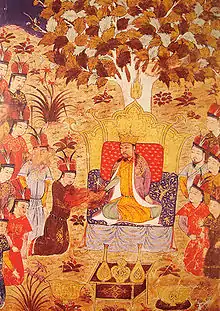
Ögedei Khan, born Ögedei (c. 1186[note 5] – December 11, 1241) was the third son of Genghis Khan and second Great Khan (Khagan) of the Mongol Empire. He continued the expansion that his father had begun and was a world figure when the Mongol Empire reached its farthest extent west and south during the invasions of Europe and Asia.[91]
Jochi
Genghis Khan was aware of the friction between his sons (particularly between Chagatai and Jochi) and worried of possible conflict between them if he died. He therefore decided to divide his empire among his sons and make all of them Khan in their own right, while appointing one of his sons as his successor. Chagatai was considered unstable due to his temper and rash behavior, because of statements he made that he would not follow Jochi if he were to become his father's successor. Tolui, Genghis Khan's youngest son, was not suitable since in Mongol culture, youngest sons were not given much responsibility due to their age. If Jochi were to become successor, it was likely that Chagatai would engage in warfare with him and collapse the empire. Therefore, Genghis Khan decided to give the throne to Ögedei. Ögedei was seen by Genghis Khan as dependable in character and relatively stable and down to earth and would be a neutral candidate that might defuse the situation between his brothers.
Jochi died in 1226, during his father's lifetime. Some scholars, notably Ratchnevsky, have commented on the possibility that Jochi was secretly poisoned by an order from Genghis Khan. Rashid al-Din reports that the great Khan sent for his sons in the spring of 1223, and while his brothers heeded the order, Jochi remained in Khorasan. Juzjani suggests that the disagreement arose from a quarrel between Jochi and his brothers in the siege of Urgench. Jochi had attempted to protect Urgench from destruction, as it belonged to territory allocated to him as a fief. He concludes his story with the clearly apocryphal statement by Jochi: "Genghis Khan is mad to have massacred so many people and laid waste so many lands. I would be doing a service if I killed my father when he is hunting, made an alliance with Sultan Muhammad, brought this land to life and gave assistance and support to the Muslims." Juzjani claims that it was in response to hearing of these plans that Genghis Khan ordered his son secretly poisoned; however, as Sultan Muhammad was already dead by 1223, the accuracy of this story is questionable.[92]
Death and burial

Genghis Khan died in August 1227, during the fall of Yinchuan, which is the capital of Western Xia. The exact cause of his death remains a mystery, and is variously attributed to being killed in action against the Western Xia, illness, falling from his horse, or wounds sustained in hunting or battle.[93][94][95] According to The Secret History of the Mongols, Genghis Khan fell from his horse while hunting and died because of the injury. He was already old and tired from his journeys. The Galician–Volhynian Chronicle alleges he was killed by the Western Xia in battle, while Marco Polo wrote that he died after the infection of an arrow wound he received during his final campaign.[96] Later Mongol chronicles connect Genghis's death with a Western Xia princess taken as war booty. One chronicle from the early 17th century even relates the legend that the princess hid a small dagger and stabbed him, though some Mongol authors have doubted this version and suspected it to be an invention by the rival Oirads.[97]
Years before his death, Genghis Khan asked to be buried without markings, according to the customs of his tribe. After he died, his body was returned to Mongolia and presumably to his birthplace in Khentii Aimag, where many assume he is buried somewhere close to the Onon River and the Burkhan Khaldun mountain (part of the Kentii mountain range). According to legend, the funeral escort killed anyone and anything across their path to conceal where he was finally buried. The Genghis Khan Mausoleum, constructed many years after his death, is his memorial, but not his burial site.
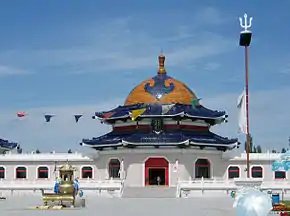
In 1939 Chinese Nationalist soldiers took the mausoleum from its position at the 'Lord's Enclosure' (Mongolian: Edsen Khoroo) in Mongolia to protect it from Japanese troops. It was taken through Communist-held territory in Yan'an some 900 km (560 mi) on carts to safety at a Buddhist monastery, the Dongshan Dafo Dian, where it remained for ten years. In 1949, as Communist troops advanced, the Nationalist soldiers moved it another 200 km (120 mi) farther west to the famous Tibetan monastery of Kumbum Monastery or Ta'er Shi near Xining, which soon fell under Communist control. In early 1954, Genghis Khan's bier and relics were returned to the Lord's Enclosure in Mongolia. By 1956 a new temple was erected there to house them.[98] In 1968 during the Cultural Revolution, Red Guards destroyed almost everything of value. The "relics" were remade in the 1970s and a great marble statue of Genghis was completed in 1989.[99]
On October 6, 2004, a joint Japanese-Mongolian archaeological dig uncovered what is believed to be Genghis Khan's palace in rural Mongolia, which raises the possibility of actually locating the ruler's long-lost burial site.[100] Folklore says that a river was diverted over his grave to make it impossible to find (the same manner of burial as the Sumerian King Gilgamesh of Uruk and Atilla the Hun). Other tales state that his grave was stampeded over by many horses, and that trees were then planted over the site, and the permafrost also did its part in hiding the burial site.
Genghis Khan left behind an army of more than 129,000 men; 28,000 were given to his various brothers and his sons. Tolui, his youngest son, inherited more than 100,000 men. This force contained the bulk of the elite Mongolian cavalry. By tradition, the youngest son inherits his father's property. Jochi, Chagatai, Ögedei Khan, and Kulan's son Gelejian received armies of 4,000 men each. His mother and the descendants of his three brothers received 3,000 men each.
Mongol Empire
Politics and economics

The Mongol Empire was governed by a civilian and military code, called the Yassa, created by Genghis Khan. The Mongol Empire did not emphasize the importance of ethnicity and race in the administrative realm, instead adopting an approach grounded in meritocracy.[101] The Mongol Empire was one of the most ethnically and culturally diverse empires in history, as befitted its size. Many of the empire's nomadic inhabitants considered themselves Mongols in military and civilian life, including Mongols, Turks and others and included many diverse Khans of various ethnicities as part of the Mongol Empire such as Muhammad Khan.
There were tax exemptions for religious figures and, to some extent, teachers and doctors. The Mongol Empire practiced religious tolerance because Mongol tradition had long held that religion was a personal concept, and not subject to law or interference.[102] Sometime before the rise of Genghis Khan, Ong Khan, his mentor and eventual rival, had converted to Nestorian Christianity. Various Mongol tribes were Shamanist, Buddhist or Christian. Religious tolerance was thus a well established concept on the Asian steppe.
Modern Mongolian historians say that towards the end of his life, Genghis Khan attempted to create a civil state under the Great Yassa that would have established the legal equality of all individuals, including women.[103] However, there is no evidence of this, or of the lifting of discriminatory policies towards sedentary peoples such as the Chinese. Women played a relatively important role in the Mongol Empire and in the family, for example Töregene Khatun was briefly in charge of the Mongol Empire while the next male leader Khagan was being chosen. Modern scholars refer to the alleged policy of encouraging trade and communication as the Pax Mongolica (Mongol Peace).
Genghis Khan realised that he needed people who could govern cities and states conquered by him. He also realised that such administrators could not be found among his Mongol people because they were nomads and thus had no experience governing cities. For this purpose Genghis Khan invited a Khitan prince, Chu'Tsai, who worked for the Jin and had been captured by the Mongol army after the Jin dynasty was defeated. Jin had captured power by displacing Khitan. Genghis told Chu'Tsai, who was a lineal descendant of Khitan rulers, that he had avenged Chu'Tsai's forefathers. Chu'Tsai responded that his father served the Jin dynasty honestly and so did he; also he did not consider his own father his enemy, so the question of revenge did not apply. This reply impressed Genghis Khan. Chu'Tsai administered parts of the Mongol Empire and became a confidant of the successive Mongol Khans.
Military

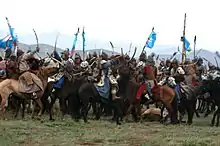
Genghis Khan put absolute trust in his generals, such as Muqali, Jebe and Subutai, and regarded them as close advisors, often extending them the same privileges and trust normally reserved for close family members. He allowed them to make decisions on their own when they embarked on campaigns far from the Mongol Empire capital Karakorum. Muqali, a trusted lieutenant, was given command of the Mongol forces against the Jin dynasty while Genghis Khan was fighting in Central Asia, and Subutai and Jebe were allowed to pursue the Great Raid into the Caucasus and Kievan Rus', an idea they had presented to the Khagan on their own initiative. While granting his generals a great deal of autonomy in making command decisions, Genghis Khan also expected unwavering loyalty from them.
The Mongol military was also successful in siege warfare, cutting off resources for cities and towns by diverting certain rivers, taking enemy prisoners and driving them in front of the army, and adopting new ideas, techniques and tools from the people they conquered, particularly in employing Muslim and Chinese siege engines and engineers to aid the Mongol cavalry in capturing cities. Another standard tactic of the Mongol military was the commonly practiced feigned retreat to break enemy formations and to lure small enemy groups away from the larger group and defended position for ambush and counterattack.
Another important aspect of the military organization of Genghis Khan was the communications and supply route or Yam, adapted from previous Chinese models. Genghis Khan dedicated special attention to this in order to speed up the gathering of military intelligence and official communications. To this end, Yam waystations were established all over the empire.[104]
Khanates
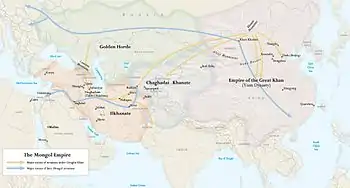
Several years before his death, Genghis Khan divided his empire among his sons Ögedei, Chagatai, Tolui, and Jochi (Jochi's death several months before Genghis Khan's meant that his lands were instead split between his sons, Batu and Orda) into several Khanates designed as sub-territories: their Khans were expected to follow the Great Khan, who was, initially, Ögedei.
Following are the Khanates as Genghis Khan assigned them:
- Empire of the Great Khan: Ögedei Khan, as Great Khan, took most of Eastern Asia, including China; this territory later to comprise the Yuan dynasty under Kublai Khan.
- Mongol homeland (present day Mongolia, including Karakorum): Tolui Khan, being the youngest son, received a small territory near the Mongol homeland, following Mongol custom.
- Chagatai Khanate: Chagatai Khan, Genghis Khan's second son, was given Central Asia and northern Iran.
- Blue Horde to Batu Khan, and White Horde to Orda Khan, both were later combined into the Kipchak Khanate, or Khanate of the Golden Horde, under Toqtamysh. Genghis Khan's eldest son, Jochi, had received most of the distant Russia and Ruthenia. Because Jochi died before Genghis Khan, his territory was further split up between his sons. Batu Khan launched an invasion of Russia, and later Hungary and Poland, and crushed several armies before being summoned back by the news of Ögedei's death.
After Genghis Khan

Contrary to popular belief, Genghis Khan did not conquer the whole area of the eventual Mongol Empire. At the time of his death in 1227, the empire stretched from the Caspian Sea to the Sea of Japan. Its expansion continued for one or more generations. Under Genghis's successor Ögedei Khan the speed of expansion reached its peak. Mongol armies pushed into Persia, finished off the Western Xia and the remnants of the Khwarezmids,[105] clashed with the imperial Song dynasty of China, and eventually took control of all of China in 1279. They also pushed further into Russia and eastern Europe.[106]
Perceptions
Like other notable conquerors, Genghis Khan is portrayed differently by conquered peoples than those who conquered with him. Negative views persist in histories written by many cultures from different geographical regions. They often cite the systematic slaughter of civilians in conquered regions, cruelties and destruction by Mongol armies. Other authors also cite positive aspects of Genghis Khan's conquests.
Positive
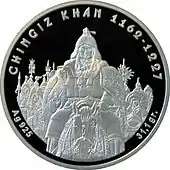
Genghis Khan is credited with bringing the Silk Road under one cohesive political environment. This allowed increased communication and trade between the West, Middle East and Asia, thus expanding the horizons of all three cultural areas. Some historians have noted that Genghis Khan instituted certain levels of meritocracy in his rule, was tolerant of religions and explained his policies clearly to all his soldiers.[107]
In Mongolia
Genghis Khan had been revered for centuries by Mongols and certain other ethnic groups such as Turks, largely because of his association with Mongol statehood, political and military organization, and his victories in war. He eventually evolved into a larger-than-life figure chiefly among the Mongols and is still considered the symbol of Mongolian culture.
During the communist period in Mongolia, Genghis was often described as a reactionary, and positive statements about him were avoided.[108] In 1962, the erection of a monument at his birthplace and a conference held in commemoration of his 800th birthday led to criticism from the Soviet Union and the dismissal of secretary Tömör-Ochir of the ruling Mongolian People's Revolutionary Party Central Committee.

In the early 1990s, the memory of Genghis Khan underwent a powerful revival, partly in reaction to its suppression during the Mongolian People's Republic period. Genghis Khan became one of the central figures of the national identity. He is considered positively by Mongolians for his role in uniting warring tribes. For example, Mongolians often refer to their country as "Genghis Khan's Mongolia", to themselves as "Genghis Khan's children", and to Genghis Khan as the "father of the Mongols" especially among the younger generation. However, there is a chasm in the perception of his brutality. Mongolians maintain that the historical records written by non-Mongolians are unfairly biased against Genghis Khan and that his butchery is exaggerated, while his positive role is underrated.[109]
In Mongolia today, Genghis Khan's name and likeness appear on products, streets, buildings, and other places. His face can be found on everyday commodities, from liquor bottles to candy, and on the largest denominations of 500, 1,000, 5,000, 10,000, and 20,000 Mongolian tögrög (₮). Mongolia's main international airport in Ulaanbaatar is named Chinggis Khaan International Airport. Major Genghis Khan statues stand before the parliament[110] and near Ulaanbaatar. There have been repeated discussions about regulating the use of his name and image to avoid trivialization.[111]
Genghis Khan is regarded as one of the most prominent leaders in Mongolia's history.[112] He is responsible for the emergence of the Mongols as a political and ethnic identity because there was no unified identity between the tribes that had cultural similarity. He reinforced many Mongol traditions and provided stability and unity during a time of almost endemic warfare between tribes. He is also credited for introducing the traditional Mongolian script and creating the first written Mongolian code of law, the Ikh Zasag ("Great Administration").[113] Mongolian President Tsakhiagiin Elbegdorj has noted that the Ikh Zasag heavily punished corruption and bribery,[114] and he considers Genghis Khan a teacher for anti-corruption efforts who sought equal protection under the law for all citizens regardless of status or wealth. On the 850th anniversary of Genghis's birth, the President stated "Chinggis ... was a man who deeply realized that the justice begins and consolidates with the equality of law, and not with the distinctions between people. He was a man who knew that the good laws and rules lived longer than fancy palaces."[115] In summary, Mongolians see him as the fundamental figure in the founding of the Mongol Empire and therefore the basis for Mongolia as a country.
As of 2012, Elbegdorj issued a decree establishing Genghis Khan's birthday as a national holiday on the first day of winter (according to the Mongolian lunar calendar).[116]
In Europe
Genghis Khan had a positive reputation among western European authors in the Middle Ages, who knew little concrete information about his empire in Asia.[117] Philosopher and inventor Roger Bacon applauded the scientific and philosophical vigor of Genghis Khan's empire,[118] and the famed writer Geoffrey Chaucer wrote concerning Genghis:
The noble king was called Genghis Khan,
Who in his time was of so great renown,
That there was nowhere in no region,
So excellent a lord in all things
The Italian explorer Marco Polo said that Genghis Khan "was a man of great worth, and of great ability, and valor."[119][120]
In Japan
Japanese such as Kenchō Suyematsu have claimed that the ethnic Japanese Minamoto no Yoshitsune was Genghis Khan.[121]
In China
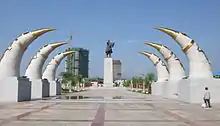
There are conflicting views of Genghis Khan in the People's Republic of China. The legacy of Genghis and his successors, who completed the conquest of China after 65 years of struggle, remains a mixed topic. China suffered a drastic decline in population.[122] The population of north China decreased from 50 million in the 1195 census to 8.5 million in the Mongol census of 1235–36. However most of them were victims of plague, floods and famine long after the war in northern China was over in 1234 and were not killed by Mongols. Since the 1340s, Yuan China experienced problems. The Yellow River flooded constantly, and other natural disasters also occurred. At the same time the Yuan dynasty required considerable military expenditure to maintain its vast empire.[123] The Black Death also contributed to the birth of the Red Turban movement. Other groups or religious sects made an effort to undermine the power of the last Yuan rulers; these religious movements often warned of impending doom. Decline of agriculture, plague and cold weather hit China, spurring the armed rebellion.[124] In Hebei, 9 out of 10 were killed by the Black Death when Toghon Temür was enthroned in 1333. Two out of three people in China had died of the plague by 1351.[125] An unknown number of people migrated to Southern China in this period.[126] James Waterson cautioned against attributing the population drop in northern China to Mongol slaughter since much of the population may have moved to southern China under the Southern Song or died of disease and famine as agricultural and urban city infrastructure were destroyed.[127] The Mongols spared cities from massacre and sacking if they surrendered like Kaifeng, which was surrendered to Subetai by Xu Li,[128] Yangzhou which was surrendered to Bayan by Li Tingzhi's second in command after Li Tingzhi was executed by the Southern Song,[129] and Hangzhou was spared from sacking when it surrendered to Kublai Khan.[130] Han Chinese and Khitan soldiers defected en masse to Genghis Khan against the Jurchen Jin dynasty.[131] Towns which surrendered were spared from sacking and massacre by Kublai Khan.[132] Khitan did not like leaving their homeland in Manchuria as the Jin moved their primary capital from Beijing south to Kaifeng and defected to the Mongols.[133]
In Inner Mongolia there are a monument and buildings dedicated to him and considerable number of ethnic Mongols in the area with a population of around 5 million, almost twice the population of Mongolia. While Genghis never conquered all of China, his grandson Kublai Khan completed that conquest and established the Yuan dynasty that is often credited with re-uniting China. There has been much artwork and literature praising Genghis as a military leader and political genius. The Mongol-established Yuan dynasty left an indelible imprint on Chinese political and social structures for subsequent generations with literature during the preceding Jin dynasty relatively fewer.[134]
In Russia
Genghis Khan has a predominantly negative reputation in Russia, although he is perceived positively in Buryatia, the republic of the Mongol-speaking Buryats in the Russian Federation. According to the chief editor of Novaya Buryatia, Timur Dugarzhapov, "Genghis Khan was always a folk hero among the Buryat people. But in Buryatia, even today, children learn ... how terrible the ‘Mongol yoke’ was, how it set Russia back and was responsible for all sort of historic ills."[135]
Negative
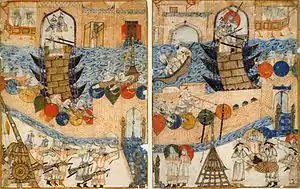
The conquests and leadership of Genghis Khan included widespread devastation and mass murder, and he, along with the Mongols in general, perpetrated what has been called ethnocide and genocide.[136][137][138][139] The targets of campaigns that refused to surrender would often be subject to reprisals in the form of enslavement and wholesale slaughter.[140] The second campaign against Western Xia, the final military action led by Genghis Khan, and during which he died, involved an intentional and systematic destruction of Western Xia cities and culture.[140] According to John Man, because of this policy of total obliteration, Western Xia is little known to anyone other than experts in the field because so little record is left of that society. He states that "There is a case to be made that this was the first ever recorded example of attempted genocide. It was certainly very successful ethnocide."[138] In the conquest of Khwarezmia under Genghis Khan, the Mongols razed the cities of Bukhara, Samarkand, Herāt, Ṭūs, and Neyshābūr and killed the respective urban populations.[141] His invasions are considered the beginning of a 200-year period known in Iran and other Islamic societies as the "Mongol catastrophe."[139] Ibn al-Athir, Ata-Malik Juvaini, Seraj al-Din Jozjani, and Rashid al-Din Fazl-Allah Hamedani, Iranian historians from the time of Mongol occupation, describe the Mongol invasions as an catastrophe never before seen.[139] A number of present-day Iranian historians, including Zabih Allah Safa, have likewise viewed the period initiated by Genghis Khan as a uniquely catastrophic era.[139] Steven R. Ward writes that the Mongol violence and depredations in the Iranian Plateau "killed up to three-fourths of the population... possibly 10 to 15 million people. Some historians have estimated that Iran's population did not again reach its pre-Mongol levels until the mid-20th century."[142]
Although the famous Mughal emperors were proud descendants of Genghis Khan and particularly Timur, they clearly distanced themselves from the Mongol atrocities committed against the Khwarizim Shahs, Turks, Persians, the citizens of Baghdad and Damascus, Nishapur, Bukhara and historical figures such as Attar of Nishapur and many other notable Muslims. However, Mughal Emperors directly patronized the legacies of Genghis Khan and Timur; together their names were synonymous with the names of other distinguished personalities particularly among the Muslim populations of South Asia.[143]
Descent
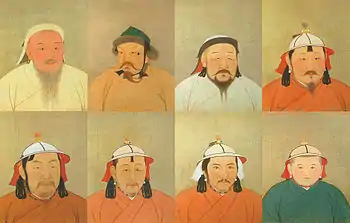
In addition to most of the Mongol nobility up to the 20th century, the Mughal emperor Babur's mother was a descendant. Timur (also known as Tamerlane), the 14th-century military leader, and many other nobilities of central Asian countries claimed descent from Genghis Khan. During the Soviet purge most of the Mongol nobility in Mongolia were purged.[144]
Physical appearance
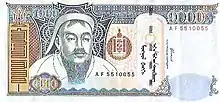
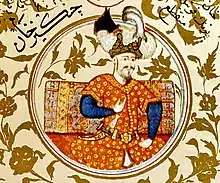
Unlike most emperors, Genghis Khan never allowed his image to be portrayed in paintings or sculptures. The earliest known images of Genghis Khan were produced half a century after his death, including the famous National Palace Museum portrait.[145][146] Though the portrait in the National Palace Museum is often considered the closest resemblance to what Genghis Khan actually looked like, it, like all others, is essentially an arbitrary rendering.[147] These earliest images were commissioned by Kublai Khan and intentionally sinicized Genghis Khan as a Mandarin, in order to posthumously legitimate him as a Chinese emperor.[148] Other portrayals of Genghis Khan from other cultures likewise characterized him according to their particular image of him. In Persia he was portrayed as a Turkish sultan, in Europe he was pictured as an ugly barbarian with a fierce face and cruel eyes.[149] According to Herbert Allen Giles, a painter known as Ho-li-hosun (also known as Khorisun or Qooriqosun ) was a Mongol commissioned by Kublai Khan in 1278 to paint the portrait of Genghis Khan (National Palace Museum portrait).[150] Under Kublai Khan supervision, he ordered Khorisun along with the other entrusted remaining followers of Genghis Khan to make sure that the portrait of Genghis Khan reflected his true image.[151]
The only individuals to have recorded Genghis Khan's physical appearance during his lifetime were the Persian chronicler Minhaj al-Siraj Juzjani and Chinese diplomat Zhao Hong.[152] Minhaj al-Siraj described Genghis Khan as "a man of tall stature, of vigorous built, robust in body, the hair of his face scanty and turned white, with cats’ eyes, possessed of dedicated energy, discernment, genius, and understanding, awe-striking...".[153] The chronicler had also previously commented on Genghis Khan's height, powerful build, with cat's eyes and lack of grey hair, based on the evidence of eyes witnesses in 1220, which saw Genghis Khan fighting in the Khorasan (modern day northwest Persia).[154][155] According to Paul Ratchnevsky, Zhao Hong, a Song dynasty envoy who visited the Mongols in 1221,[156] described Genghis Khan as "of tall and majestic stature, his brow is broad and his beard is long".[154]
Other descriptions of Genghis Khan come from 14th century texts. The Persian historian Rashid-al-Din in Jami' al-tawarikh, written in the beginning of the 14th century, stated that most Borjigin ancestors of Genghis Khan were "tall, long-bearded, red-haired, and bluish green-eyed," features which Genghis Khan himself had. The factual nature of this statement is considered controversial by some modern researchers.[147] In the Georgian Chronicles, in a passage written in the 14th century, Genghis Khan is similarly described as a large, good-looking man, with red hair.[157] However, according to John Andrew Boyle, Rashid al-Din's text of red hair referred to ruddy skin complexion, and that Genghis Khan was of ruddy complexion like most of his children except for Kublai Khan who was swarthy. He translated the text as “It chanced that he was born 2 months before Möge, and when Chingiz-Khan’s eye fell upon him he said: “all our children are of a ruddy complexion, but this child is swarthy like his maternal uncles. Tell Sorqoqtani Beki to give him to a good nurse to be reared”.[158] 14th century Arabic historian Shihab al-Umari also disputed Rashid al-Din's translation and claimed Alan Gua falsified the origin of her clan.[159] Some Historians such as Denise Aigle claimed that Rashid al-Din mythicized the origin of Genghis Khan ancestors (the Borjigin clan) through his own interpretations of The Secret History of the Mongols. Italian historian Igor de Rachewiltz claimed that the Mongol origins of the early ancestors of Genghis Khan were animals born from the blue eye wolf (Borte Chino) and the fallow doe (Qo'ai Maral) that was described in the early legends, that their ancestors were animals.[160]
Depictions in modern culture
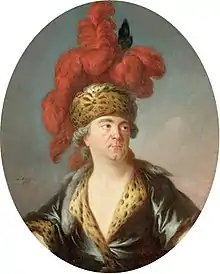
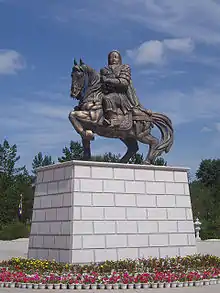
There have been several films, novels and other adaptation works on the Mongolian ruler.
Films
- Genghis Khan, a 1950 Philippine film directed by Manuel Conde.
- The Conqueror, released in 1956 and starring John Wayne as Temüjin and Susan Hayward as Börte.
- Changez Khan, a 1957 Indian Hindi-language film directed by Kedar Kapoor, starring Sheikh Mukhtar as the emperor along with Bina Rai and Prem Nath in the lead roles.[161]
- Genghis Khan, a 1965 film starring Omar Sharif.
- Under the Eternal Blue Sky, a Mongolian film directed by Baljinnyam, which was released in 1990. Starring Agvaantserengiin Enkhtaivan as Temüjin.
- Genghis Khan, an unfinished 1992 film starring Richard Tyson, Charlton Heston and Pat Morita.
- Genghis Khan – A Proud Son Of Heaven, a 1998 film made in Mongolian, with English subtitles.
- Genghis Khan: To the Ends of the Earth and Sea, also known as The Descendant of Gray Wolf, a Japanese-Mongolian film released in 2007.
- Mongol, a film by Sergei Bodrov released in 2007. (Academy Award nominee for Best Foreign Language Film).
- No Right to Die – Chinggis Khaan, a Mongolian film released in 2008.
Television series
- Genghis Khan, a 1987 Hong Kong television series produced by TVB, starring Alex Man.
- Genghis Khan, a 1987 Hong Kong television series produced by ATV, starring Tony Liu.
- Genghis Khan, a 2004 Chinese-Mongolian co-produced television series, starring Ba Sen, who is a descendant of Genghis Khan's second son Chagatai.
Poetry
- "The Squire's Tale", one of The Canterbury Tales by Geoffrey Chaucer, is set at the court of Genghis Khan.
- The End of Genghis, a poem by F. L. Lucas, in which the dying Khan, attended by his Khitan counsellor Yelü Chucai, looks back on his life.[162]
Novels
- The Conqueror series of novels by Conn Iggulden
- Steppe by Piers Anthony
- Genghis Khan (Last incarnation) in Metro 2033 by Dmitry Glukhovsky
- White cloud of Genghis Khan by Chingiz Aitmatov[163]
Short stories
Music
- West German pop band Dschinghis Khan took its name from the German-language spelling of Genghis Khan. They participated in the Eurovision Song Contest 1979 with their song of the same name.
- Heavy metal band Iron Maiden released an all-instrumental track titled "Genghis Khan" on their 1981 sophomore album Killers.
- The band Miike Snow released the song "Genghis Khan" in 2017.
- Mongolian Folk-Rock band The Hu released a song called The Great Chinggis Khaan in August 2019.[164]
Video games
- Age of Empires II: The Age of Kings
- Aoki Ookami to Shiroki Mejika IV: Genghis Khan
- Crusader Kings 2
- Deadliest Warrior: Legends
- Sid Meier's Civilization
Name and title
There are many theories about the origins of Temüjin's title. Since people of the Mongol nation later associated the name with ching (Mongolian for strength), such confusion is obvious, though it does not follow etymology.
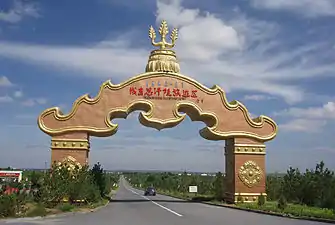
One theory suggests the name stems from a palatalised version of the Mongolic and Turkic word tenggis/tengiz, meaning "sea", "ocean", "oceanic" or "wide-spreading". (Lake Baikal and other large bodies of water were called tenggis by the Mongols). This view was repeated by, among others, the Big Russian Encyclopedia;[10]. However, it seems that if they had meant to call Genghis tenggis they could have said, and written, "Tenggis Khan", which they did not. Zhèng (Chinese: 正) meaning "right", "just", or "true", would have received the Mongolian adjectival modifier -s, creating "Jenggis", which in medieval romanization would be written "Genghis". It is likely that the 13th-century Mongolian pronunciation would have closely matched "Chinggis".[165]
The English spelling "Genghis" is of unclear origin. Weatherford claims it derives from a spelling used in original Persian reports. Even at this time some Iranians pronounce his name as "Ghengiss". However, review of historical Persian sources does not confirm this.[166]
According to the Secret History of the Mongols, Temüjin was named after a powerful warrior of the Tatar tribe that his father Yesügei had taken prisoner. The name "Temüjin" is believed to derive from the word temür, Turkic for iron (modern Mongolian: төмөр, tömör). The name would imply a blacksmith or a man strong like iron.
No evidence has survived to indicate that Genghis Khan had any exceptional training or reputation as a blacksmith. But the latter interpretation (a man strong like iron) is supported by the names of Genghis Khan's siblings, Temülin and Temüge, which are derived from the same root word.
Name and spelling variations
Genghis Khan is spelled in a variety of ways in different languages such as Mongolian Chinggis Khaan, English Chinghiz, Chinghis, and Chingiz, Chinese: 成吉思汗; pinyin: Chéngjísī Hán, Turkic: Cengiz Han, Çingiz Xan, Chingizxon, Shın'g'ısxan, Çingiz Han Çıñğız Xan, Şıñğıs xan, Çiñğiz Xaan, Çiñğizhan, Russian: Чингисхан (Čingiskhan) or Чингиз-хан (Čingiz-khan), etc. Temüjin is written in Chinese as simplified Chinese: 铁木真; traditional Chinese: 鐵木眞; pinyin: Tiěmùzhēn.
When Kublai Khan established the Yuan dynasty in 1271, he had his grandfather Genghis Khan placed on the official record as the founder of the dynasty or Taizu (Chinese: 太祖). Thus, Genghis Khan is also referred to as Yuan Taizu (Emperor Taizu of Yuan, Chinese: 元太祖) in Chinese historiography.
Timeline
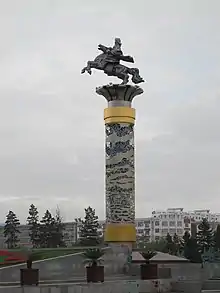
- Probably 1155 or 1162: Temüjin was born in the Khentii mountains.
- When Temüjin was nine, his father Yesükhei was poisoned by Tatars, leaving Temüjin and his family destitute.
- c. 1184: Temüjin's wife Börte was kidnapped by Merkits; he called on blood brother Jamukha and Wang Khan for aid, and they rescued her.
- c. 1185: First son Jochi was born; leading to doubt about his paternity later among Genghis's children, because he was born shortly after Börte's rescue from the Merkits.
- 1190: Temüjin united the Mongol tribes, became leader, and devised code of law Yassa.
- 1201: Victory over Jamukha's Jadarans.
- 1202: Adopted as Wang Khan's heir after successful campaigns against Tatars.
- 1203: Victory over Wang Khan's Keraites. Wang Khan himself killed by accident by allied Naimans.
- 1204: Victory over Naimans (all these confederations unite and become the Mongols).
- 1206: Jamukha was killed. Temüjin was given the title Genghis Khan by his followers in a Kurultai (around 40 years of age).
- 1207–1210: Genghis led operations against the Western Xia, which comprises much of northwestern China and parts of Tibet. Western Xia ruler submitted to Genghis Khan. During this period, the Uyghurs also submitted peacefully to the Mongols and became valued administrators throughout the empire.
- 1211: After the kurultai, Genghis led his armies against the Jin dynasty ruling northern China.
- 1215: Beijing fell; Genghis Khan turned to west and the Khara-Kitan Khanate.
- 1219–1222: Conquered Khwarezmid Empire.
- 1226: Started the campaign against the Western Xia for forming coalition against the Mongols, the second battle with the Western Xia.
- 1227: Genghis Khan died after conquering the Tangut people. Cause of death is uncertain.
Notes
- English: /təˈmuːdʒɪn/, sometimes also written as Temuchin or Temujin; Mongolian: Тэмүжин, romanized: Temüjin [tʰemut͡ʃiŋ] (
 listen); Middle Mongolian: Temüjin;[2] traditional Chinese: 鐵木真; simplified Chinese: 铁木真; pinyin: Tiěmùzhēn; Wade–Giles: T'ieh3-mu4-chen1.
listen); Middle Mongolian: Temüjin;[2] traditional Chinese: 鐵木真; simplified Chinese: 铁木真; pinyin: Tiěmùzhēn; Wade–Giles: T'ieh3-mu4-chen1. - Rashid al-Din asserts that Genghis Khan was born in 1155, while the History of Yuan records his year of birth as 1162. According to Ratchnevsky, accepting a birth in 1155 would render Genghis Khan a father at the age of 30 and would imply that he personally commanded the expedition against the Tanguts at the age of 72. Also, according to the Altan Tobci, Genghis Khan's sister, Temülin, was nine years younger than he; but the Secret History relates that Temülin was an infant during the attack by the Merkits, during which Genghis Khan would have been 18, had he been born in 1155. Zhao Hong reports in his travelogue that the Mongols he questioned did not know and had never known their ages.
- Chinese: 成吉思汗; pinyin: Chéngjísī Hán; Wade–Giles: Ch'eng2-chi2-szu1 Han4.
- Historians of the Mongol empire generally prefer the spelling Chinggis Khaan, which more closely approximates the name in Mongolian, Чингис хаан [t͡ʃʰiŋɡɪs xaːŋ] (
 listen).[7] The English spelling of his name came originally from Italian, hence the pronunciation /ˌdʒɛŋɡɪs ˈkɑːn/, which is similar to the Italian pronunciation; the second G has a following H to produce the sound [ɡ], as in spaghetti. But because G before E in English is ambiguous (cf. get vs. gel), this leads to the common pronunciation of /ˌɡɛŋɡɪs ˈkɑːn/, with both Gs producing the sound /ɡ/, which has led to the alternate spelling Jenghis Khan to try to prevent this.[8]
listen).[7] The English spelling of his name came originally from Italian, hence the pronunciation /ˌdʒɛŋɡɪs ˈkɑːn/, which is similar to the Italian pronunciation; the second G has a following H to produce the sound [ɡ], as in spaghetti. But because G before E in English is ambiguous (cf. get vs. gel), this leads to the common pronunciation of /ˌɡɛŋɡɪs ˈkɑːn/, with both Gs producing the sound /ɡ/, which has led to the alternate spelling Jenghis Khan to try to prevent this.[8]
The Middle Mongol pronunciation was IPA: [ˈt͡ɕʰiŋːɡis ˈkaχaːn] or IPA: [ˈt͡ʃʰiŋːɡis ˈqaχaːn].[9] - "Ogedei died at the age of 56 by Chinese historical standards (55 by modern western standards) in 1241, meaning he was born in 1186"
References
Citations
- Biran, Michal (2012). Chinggis Khan. ISBN 978-1-78074-204-5.
- "Central Asiatic Journal". Central Asiatic Journal. 5: 239. 1959. Retrieved July 29, 2011.
- Ratchnevsky 1991, p. 142, "It is possible, however, to say with certainty that Genghis Khan died in August 1227; only in specifying the actual day of his death do our sources disagree."
- Fiaschetti, Francesca (2014). "Tradition, Innovation and the construction of Qubilai's diplomacy" (PDF). Ming Qing Yanjiu. 18 (1): 82. Retrieved January 10, 2020.
- Porter, Jonathan (2016). Imperial China, 1350–1900. p. 24. ISBN 978-1-4422-2293-9.
- Zhao, George (2008). Marriage as Political Strategy and Cultural Expression: Mongolian Royal Marriages from World Empire to Yuan Dynasty. p. 237. ISBN 978-1-4331-0275-2.
- Morgan 1986, p. 186.
- Pronunciation references:
- "Genghis Khan". The American Heritage Dictionary of the English Language (5th ed.). Boston: Houghton Mifflin Harcourt.
- "Genghis Khan". Webster's New World College Dictionary. Wiley Publishing. 2004. Retrieved July 29, 2011.
- "Genghis Khan". Oxford Dictionaries UK Dictionary. Oxford University Press. Retrieved July 29, 2011.
- NativLang, What Genghis Khan's Mongolian Sounded Like – and how we know, retrieved December 28, 2018
- ЧИНГИСХА́Н — Big Russian Encyclopedia, 2010
- Weatherford, Jack (October 25, 2016). Genghis Khan and the Quest for God: How the World's Greatest Conqueror Gave Us Religious Freedom. Penguin. ISBN 978-0-7352-2116-1.
- Saunders, John Joseph (2001) [1972]. History of the Mongol Conquests. Philadelphia: University of Pennsylvania Press. ISBN 978-0-8122-1766-7.
- Man 2007, pp. 254–255.
- Ian Jeffries (2007). Mongolia: a guide to economic and political developments. Taylor & Francis. pp. 5–7. ISBN 0-415-42545-X.
- "Genghis Khan". North Georgia College and State University. Archived from the original on March 6, 2010. Retrieved January 26, 2010.
- "Mongol empire – The Golden Horde". Encyclopedia Britannica. Retrieved April 10, 2020.
- Ratchnevsky 1991, pp. 9–10.
- Derenko 2007, p. 5.
- Narod and Derenko 2007, p. 2.
- Lee 2016, p. 4-6.
- Campbell, Mike. "Meaning, origin and history of the name Temujin". Behind the Name. Retrieved March 29, 2016.
- Glasse, Cyril; Smith, Huston (January 2003). The New Encyclopedia of Islam. p. 313. ISBN 978-0-7591-0190-6.
- Morgan 1986, p. 58.
- Guida Myrl Jackson-Laufer, Guida M. Jackson, Encyclopedia of traditional epics, p. 527
- Kahn, Paul (adaptor) (1998). Secret History of the Mongols: The Origin of Chingis Khan (expanded edition): An Adaptation of the Yüan chʾao pi shih, Based Primarily on the English Translation by Francis Woodman Cleaves. Asian Culture Series. Boston: Cheng & Tsui Co. p. 192. ISBN 978-0-88727-299-8.
- Columbia 2019, p. 3.
- Lee 2016, p. 3.
- Rachewiltz 2015, p. 3.
- Atwood 2018, p. 2.
- "Redefining Your Circumstances: Genghis Khan's Rise to Ruler of the World". Man of 300. March 17, 2018. Retrieved March 29, 2018.
- Weatherford 2005, p. 23.
- Atwood 2018, p. 5.
- Rachewiltz 2015, p. 7.
- Columbia 2019, p. 6.
- Rachewiltz 2015, p. 5.
- McLynn 2015, p. 169.
- Broadbridge 2018, pp. 74, 92.
- Broadbridge 2018, pp. 14, 74, 104.
- Broadbridge 2018, pp. 19–20.
- Street 2015, pp. 12–14.
- Broadbridge 2018, p. 49.
- Broadbridge 2018, pp. 50–51.
- Street 2015, pp. 27–28.
- Broadbridge 2018, pp. 56–57.
- Broadbridge 2018, pp. 62–63.
- Street 2015, p. 33.
- Broadbridge 2018, pp. 63–64.
- Weatherford, Jack. (2010). The Secret History of the Mongol Queens. Broadway Paperbacks, New York. p. 2.
- Broadbridge 2018, pp. 83–84.
- Street 2015, p. 73.
- Broadbridge 2018, p. 85.
- Broadbridge 2018, p. 84.
- Craughwell, Thomas J. The Rise and Fall of the Second Largest Empire in History: How Genghis Khan's Mongols Almost Conquered the World. p. 159.
- Broadbridge 2018, p. 88.
- Broadbridge 2018, p. 89.
- McLynn 2015, p. 165.
- De Nicola, Bruno (2017). Women in Mongol Iran: The Khatuns, 1206–1335. Edinburgh University Press. p. 68.
- Broadbridge 2018, p. 168.
- Jami' al-tawarikh, Part 1, Volume 2, Section 2
- Broadbridge, Anne F. (2018). Women and the Making of the Mongol Empire. Cambridge: Cambridge University Press. pp. 81–3. ISBN 978-1-108-42489-9.
- De Nicola, Bruno (June 9, 2016). "Chapter 4: The Economic Role of Mongol Women: Continuity and Transformation from Mongolia to Iran". In De Nicola, Bruno; Melville, Charles (eds.). The Mongols' Middle East: Continuity and Transformation in Ilkhanid Iran. Leiden: BRILL. pp. 80, n. 8. ISBN 978-90-04-31472-6.
- Broadbridge, Anne F. (2018). Women and the Making of the Mongol Empire. Cambridge: Cambridge University Press. pp. 81–3. ISBN 978-1-108-42489-9.
- May, Timothy (October 2015). "Commercial Queens: Mongolian Khatuns and the Silk Road". Journal of the Royal Asiatic Society. 26 (1–2): 89–106. doi:10.1017/S1356186315000590 – via ResearchGate.
- De Nicola, 2016, 82
- Grousset, Rene (1944). Conqueror of the World: The Life of Chingis-khagan. New York, NY: Viking Press.
- Hildinger 1997, p. 113.
- Hildinger 1997, p. 114.
- Lane 2004, p. xxvii.
- Weatherford 2005, p. .
- Lane 2004, p. 23.
- Biran, Michal (2012). Genghis Khan. London: Oneworld Publications. p. 35. ISBN 978-1-78074-204-5.
- Weatherford, Jack (2004). "2: Tale of Three Rivers". Genghis Khan and the Making of the Modern World. Three Rivers Press. p. 44. ISBN 978-0-609-80964-8.
- Man 2007, p. .
- Abbott 2014, p. 362.
- Hyslop, Stephen Garrison; Daniels, Patricia; Society (U.S.), National Geographic (2011). Great Empires: An Illustrated Atlas. National Geographic Books. pp. 174, 179. ISBN 978-1-4262-0829-4.
- Cummins, Joseph (May 1, 2011). History's Greatest Wars: The Epic Conflicts that Shaped the Modern World. Fair Winds Press. p. 95. ISBN 978-1-61058-055-7.
- Eskildsen, Stephen (2004). The Teachings and Practices of the Early Quanzhen Taoist Masters. SUNY Press. p. 17. ISBN 978-0-7914-6045-0.
- Atwood 2004, p. 245.
- Wang, Feifei. "Not Quite a Hybrid System: Khubilai's Buddhist Administration in Southeastern China" (PDF). National University of Singapore. pp. 216–217.
- Jagchid 1979, p. 12.
- Jagchid 1979, pp. 14–19.
- Atwood 2004, p. 239.
- Atwood 2004, pp. 246–248.
- Stephen Pow: The Last Campaign and Death of Jebe Noyan. In: Journal of the Royal Asiatic Society. Vol. 27, Nr. 1. Cambridge University Press, Cambridge 2017, p. 5.
- Enerelt Enkhbold, 2019. "The role of the ortoq in the Mongol Empire in forming business partnerships", Central Asian Survey 38 (4), 1–17
- Modelski, George (September 29, 2007). "Central Asian world cities?". University of Washington. Archived from the original on January 18, 2012.
- Morgan 1986, p. .
- John Chambers, The Devil's Horsemen: The Mongol Invasion of Europe, Atheneum, 1979. p. 31
- Stephen Pow: The Last Campaign and Death of Jebe Noyan. In: Journal of the Royal Asiatic Society. Vol. 27, Nr. 1. Cambridge University Press, Cambridge 2017, S. 31–51 (englisch).
- Ratchnevsky 1991, p. 126.
- "The Era of Golden Age". TDML. Retrieved September 22, 2020.
- Ratchnevsky 1991, pp. 136–137.
- Emmons, James B. (2012). "Genghis Khan". In Li, Xiaobing (ed.). China at War: An Encyclopedia. Santa Barbara, California: ABC-CLIO. p. 139. ISBN 978-1-59884-415-3. Retrieved August 21, 2013.
- Hart-Davis, Adam (2007). History: From the Dawn of Civilization to the Present Day. London: Dorling Kindersley. p. 165. ISBN 978-1-4053-1809-9.
- Man 2007, pp. 239–240.
- Lange, Brenda (2003). Genghis Khan. New York City: Infobase Publishing. p. 71. ISBN 978-0-7910-7222-6.
- Heissig, Walther (1964). Die Mongolen. Ein Volk sucht seine Geschichte. Düsseldorf. p. 124.
- Man 2007, pp. 329–333.
- Man 2007, p. 338.
- "Palace of Genghis Khan unearthed". BBC. October 7, 2004. Retrieved May 20, 2008.
- Jack Weatherford. Genghis Khan and the Making of the Modern World. New York: Three Rivers Press, 2004.
- Amy Chua. Day of Empire: How hyperpowers rise to global dominance, and why they fall. New York: Random House, 2007. p.95
- Pocha, Jehangir S. (May 10, 2005). "Mongolia sees Genghis Khan's good side". International Herald Tribune. Retrieved May 20, 2008.
- Jack Weatherford, Genghis Khan: War of the Khans (New York: Random House, Inc., 2004), 58
- Wikipedia 2007, p. 14.
- Wikipedia 2007, p. 15.
- Clive Foss, The Tyrants, page 57, Quercus, London, 2007.
- Christopher Kaplonski: The case of the disappearing Chinggis Khaan.
- Griffiths, Daniel (January 11, 2007). "Asia-Pacific | Post-communist Mongolia's struggle". BBC News. Retrieved August 3, 2009.
- "Once Shunned, Genghis Khan Conquers Mongolia Again". Archived from the original on November 3, 2007. Retrieved July 24, 2006.
- "Business | Genghis Khan may get protection". BBC News. October 6, 2006. Retrieved August 3, 2009.
- "ASIA-PACIFIC | Mongolia glorifies Genghis Khan". BBC News. May 3, 2002. Retrieved August 3, 2009.
- "The Yasa of Chingis Khan". Retrieved February 16, 2010.
- "Speech of President Elbegdorj at introduction of Partnering Against Corruption Initiative". Office of the President of Mongolia. March 3, 2011. Archived from the original on March 13, 2012. Retrieved August 1, 2013.
- "Speech by Tsakhiagiin Elbegdorj, President of Mongolia at a solemn assembly, dedicated to the 850th anniversary of birth of Chinggis Khaan". Office of the President of Mongolia. November 14, 2012. Retrieved June 21, 2013.
- "Mongolia to celebrate the birthday of Great Chinggis Khaan". InfoMongolia.com. Archived from the original on October 14, 2013. Retrieved October 12, 2013.
- Weatherford 2005, p. 239.
- Weatherford 2005, p. xxiv.
- Polo, Marco (1905). The Adventures of Marco Polo. D. Appleton and Company. p. 21.
- Brooks, Noah (October 1, 2008). The Story of Marco Polo. Cosimo, Inc. p. 81. ISBN 978-1-60520-280-8.
- Miyawaki-Okada, Junko (2006). "The Japanese Origin of the Chinggis Khan Legends". Inner Asia. 8 (1): 123–134. doi:10.1163/146481706793646819. JSTOR 23615520.
- William Bonner, Addison Wiggin (2006). "Empire of debt: the rise of an epic financial crisis". John Wiley and Sons. pp.43–44. ISBN 0-471-73902-2
- Yuan Dynasty: Ancient China Dynasties, paragraph 3.
- Brook, Timothy (1999). The Confusions of Pleasure: Commerce and Culture in Ming China (illustrated, reprint ed.). University of California Press. p. 18. ISBN 978-0-520-22154-3.
- Chua, Amy (2009). Day of Empire: How Hyperpowers Rise to Global Dominance—and Why They Fall. Knopf Doubleday Publishing Group. p. 123. ISBN 978-0-307-47245-8.
- Graziella Caselli, Gillaume Wunsch, Jacques Vallin (2005). "Demography: Analysis and Synthesis, Four Volume Set: A Treatise in Population". Academic Press. p. 34. ISBN 0-12-765660-X
- Waterson 2013, p. 88.
- Waterson 2013, p. 92.
- Waterson 2013, p. 230.
- Balfour, Alan H.; Zheng, Shiling (2002). Balfour, Alan H. (ed.). Shanghai (illustrated ed.). Wiley-Academy. p. 25. ISBN 0-471-87733-6.
- Waterson 2013, p. 84.
- Coatsworth, John; Cole, Juan Ricardo; Hanagan, Michael P.; Perdue, Peter C.; Tilly, Charles; Tilly, Louise (2015). Global Connections: Politics, Exchange, and Social Life in World History. 1 (illustrated ed.). Cambridge University Press. p. 356. ISBN 978-0-521-19189-0.
- Man 2007, pp. 141.
- Abbott 2014, p. 54.
- Weir, Fred (August 17, 2018). "Russia takes a new look at an old enemy: Genghis Khan". CSMonitor.
- Jonassohn & Björnson 1999, p. 276.
- Jacobs 1999, pp. 247–248.
- Man 2007, pp. 116–117.
- Edelat, Abbas (2010). "Trauma Hypothesis: The enduring legacy of the Mongol Catastrophe on the Political, Social and Scientific History of Iran" (PDF). Bukhara. 13 (77–78): 277–263 – via Imperial College London.
- "Mongol empire | Facts, History, & Map". Encyclopedia Britannica. Retrieved April 24, 2020.
- "Iran – The Mongol invasion". Encyclopedia Britannica. Retrieved April 26, 2020.
- Ward, Steven R. (2009). Immortal: a military history of Iran and its armed forces. Georgetown University Press. p. 39. ISBN 978-1-58901-258-5.
- Abbott 2014, p. 507.
- Mughal 2009, p. 4.
- "Portraits of Emperors T'ai-tsu (Chinggis Khan), Shih-tsu (Khubilai Khan), and Wen-tsung (Tegtemur)". National Palace Museum.
- Shambaugh Elliott, Jeanette; Shambaugh, David (August 3, 2015). The Odyssey of China's Imperial Art Treasures. University of Washington Press. p. 30. ISBN 978-0-295-99755-1.
- Lkhagvasuren, Gavaachimed; Shin, Heejin; Lee, Si Eun; Tumen, Dashtseveg; Kim, Jae-Hyun; Kim, Kyung-Yong; Kim, Kijeong; Park, Ae Ja; Lee, Ho Woon; Kim, Mi Jin; Choi, Jaesung (September 14, 2016). "Molecular Genealogy of a Mongol Queen's Family and Her Possible Kinship with Genghis Khan". PLoS ONE. 11 (9): e0161622. Bibcode:2016PLoSO..1161622L. doi:10.1371/journal.pone.0161622. ISSN 1932-6203. PMC 5023095. PMID 27627454.
- Weatherford 2005, pp. 24–25, 197.
- Weatherford 2005, p. 25.
- Allen Giles, Herbert (1918). An Introduction to the History of Chinese Pictorial Art. London, England: London, B. Quaritch.
- Currie, Lorenzo (2013). Through the Eyes of the Pack. Bloomington, Indiana, United States: Xlibris. p. 171. ISBN 978-1-4931-4517-1.
- Grousset, René (January 30, 1970). The Empire of the Steppes: A History of Central Asia. New Brunswick, NJlanguage=en: Rutgers University Press. ISBN 978-0-8135-1304-1.
- Weatherford 2005, p. 6.
- Mote, Frederick W. (2003). Imperial China 900–1800. Cambridge, Massachusetts: Harvard University Press. p. 433. ISBN 978-0-674-01212-7.
- Peers, Chris (2015). Genghis Khan and the Mongol War Machine. Pen & Sword Military. ISBN 978-1-78340-056-0.
- Allsen, Thomas (2001). "The Circulation of Military Technology in the Mongolian Empire". In Di Cosmo, Nicola (ed.). Warfare in Inner Asian History (500–1800). Leiden: Brill Publishers. p. 268. ISBN 978-90-04-39178-9.
- Brosset, Marie-Félicité. Histoire de la Georgie. Saint Petersburg, Russia: Imperial Academy of Sciences. p. 488.[...] le même que Tchingii-Qaen, homme de belle tournure, de belle taille, robuste, ayant les cheveux roux, doué d'énergie, de bravoure et d'intrépidité
- Andrew Boyle, John. The Successors of Genghis Khan. New York, 1971: Robert Bedrosian. p. 241.CS1 maint: location (link) “It chanced that he was born 2 months before Möge, and when Chingiz-Khan’s eye fell upon him he said: “all our children are of a ruddy complexion, but this child is swarthy like his maternal uncles. Tell Sorqoqtani Beki to give him to a good nurse to be reared.”” -Rashid al-Din/Boyle translation, 241.
- Aigle, Denise (October 28, 2014). The Mongol Empire between Myth and Reality: Studies in Anthropological History. p. 126, 127. ISBN 978-90-04-28064-9.[...] " I was not made pregnant by anyone (ma hamaltu min aha). I was sitting down; my window was open. A light came in through it, three times. As for me, I was pregnant with these three sons, for that light enteres each time with a boy [They say that] these sons were concived in sole womb )fi batn in wahid" Buqun Qataghi, Busun Salji and Budhunjar. They are called nuraniyyun because of the light that penetrated their mother. That is why Genghis Khan is called the son of the sun – Shihab al-Umari
- Aigle, Denise (October 28, 2014). The Mongol Empire between Myth and Reality: Studies in Anthropological History. p. 126, 127. ISBN 978-90-04-28064-9.
- Hervé Dumont (2009). L'Antiquité au cinéma: vérités, légendes et manipulations. Nouveau Monde. p. 242. ISBN 978-2-84736-476-7.
- Lucas, F. L., From Many Times and Lands (London, 1953), pp. 148–155
- "In Ufa held the premiere of "White Cloud of Genghis Khan" Chingiz Aitmatov". February 21, 2019.
- "Mongolian Folk-Rockers The Hu Release Video For 'The Great Chinggis Khaan,' Ready Album, U.S. Tour". Billboard. Retrieved August 24, 2019.
- Lister, R. P. (2000) [c1969]. Genghis Khan. Lanham, Maryland: Cooper Square Press. ISBN 978-0-8154-1052-2.
- Timothy May. "Book Review". North Georgia College and State University. Archived from the original on October 10, 2007. Retrieved February 20, 2008.
Sources
- Atwood, Christopher P. (June 2004). "Validation by Holiness or Sovereignty: Religious Toleration as Political Theology in the Mongol World Empire of the Thirteenth Century" (PDF). The International History Review. 26 (2): 237–256. doi:10.1080/07075332.2004.9641030. JSTOR 40109471. S2CID 159826445.
- Broadbridge, Anne F. (July 18, 2018). Women and the Making of the Mongol Empire. Cambridge University Press. ISBN 978-1-108-63662-9.
- Hildinger, Erik (1997). Warriors Of The Steppe: Military History Of Central Asia, 500 BC To 1700 AD. Cambridge, England: Da Capo Press. ISBN 978-0-7867-3114-5.
- Jacobs, Steven L. (1999). "Genghis Khan". In Charny, Israel W. (ed.). Encyclopedia of Genocide: A-H. 1. Santa Barbara: ABC-CLIO. pp. 247–248. ISBN 978-0-87436-928-1.
- Jagchid, Sechin (1979). "The Mongol Khans and Chinese Buddhism and Taoism". The Journal of the International Association of Buddhist Studies. 2 (1): 7–28.
- Jonassohn, Kurt; Björnson, Karin Solveig (1999). "Genocides During the Middle Ages". In Charny, Israel W. (ed.). Encyclopedia of Genocide: A-H. 1. Santa Barbara: ABC-CLIO. pp. 275–277. ISBN 978-0-87436-928-1.
- Lane, George (2004). Genghis Khan and Mongol Rule. Westport, Connecticut: Greenwood Publishing Group. ISBN 978-0-313-32528-1.
- Man, John (2007). Genghis Khan: Life, Death, and Resurrection. New York, NY: St. Martin's Press. ISBN 978-0-312-36624-7.
- McLynn, Frank (2015). Genghis Khan: His Conquests, His Empire, His Legacy. Hachette Books. ISBN 978-0-306-82395-4.
- Morgan, David (1986). The Mongols. The Peoples of Europe. Blackwell Publishing. ISBN 978-0-631-17563-6.
- Ratchnevsky, Paul (1991). Thomas Nivison Haining (ed.). Genghis Khan: His Life and Legacy [Čingis-Khan: sein Leben und Wirken]. Translated by Thomas Nivison Haining. Oxford, England; Cambridge, Massachusetts: B. Blackwell. ISBN 978-0-631-16785-3.
- Waterson, James (2013). Defending Heaven: China's Mongol Wars, 1209-1370. Casemate Publishers. ISBN 978-1-783-46943-7.
- Weatherford, Jack (March 22, 2005). Genghis Khan and the Making of the Modern World. Crown. ISBN 978-0-307-23781-1.
Primary sources
- Juvaynī, Alā al-Dīn Atā Malik, 1226–1283 (1997). Genghis Khan: The History of the World-Conqueror [Tarīkh-i jahāngushā]. Translated by John Andrew Boyle. Seattle, WA: University of Washington Press. ISBN 978-0-295-97654-9.
- Juvaini, 'ala-ad-Din 'Ata-Malik (1958). History of the World-Conqueror. Translated by John Andrew Boyle. Cambridge, MA: Harvard University Press. p. 361. Retrieved April 16, 2012.
- Rashid al-Din Tabib (1995). Sheila S. Blair (ed.). A Compendium of Chronicles: Rashid al-Din's Illustrated History of the World Jami' al-Tawarikh. The Nasser D. Khalili Collection of Islamic Art, Vol. XXVII. Oxford, England: Oxford University Press. ISBN 978-0-19-727627-3.
- Rashid al-Din Tabib (1971). The Successors of Genghis Khan (extracts from Jami' Al-Tawarikh). UNESCO Collection of Representative Works: Persian heritage series. Translated by John Andrew Boyle from the Persian. New York, NY: Columbia University Press. ISBN 978-0-231-03351-0.
- Street, John C., ed. (December 2015). "The Secret History of the Mongols: A Mongolian Epic Chronicle of the Thirteenth Century". Shorter version. University of Wisconsin―Madison. Books and Monographs – via Western CEDAR, Western Washington University.
- Rachewiltz, Igor de (2004). The Secret History of the Mongols: A Mongolian Epic Chronicle of the Thirteenth Century [Yuan chao bi shi]. Brill's Inner Asian Library. 7. Translated by Igor de Rachewiltz. Leiden, South Holland; Boston, MA: Brill. ISBN 978-90-04-13159-0.
Further reading
| Library resources about Genghis Khan |
- "Genghis Khan". Funk & Wagnalls New Encyclopedia. World Almanac Education Group. 2005. Archived from the original on January 13, 2006. Retrieved May 22, 2008 – via History Channel.
- Brent, Peter (1976). The Mongol Empire: Genghis Khan: His Triumph and His Legacy. London: Weidenfeld & Nicolson. ISBN 978-0-297-77137-1.
- Bretschneider, Emilii (2002). Mediæval Researches from Eastern Asiatic Sources; Fragments Towards the Knowledge of the Geography & History of Central & Western Asia. Adamant Media Corporation. ISBN 978-1-4021-9303-3. This Elibron Classics book is a facsimile reprint of an 1888 edition by Trübner & Co., London.
- Cable, Mildred; French, Francesca (1943). The Gobi Desert. London, England: Landsborough Publications.
- Chapin, David (2012). Long Lines: Ten of the World's Longest Continuous Family Lineages. VirtualBookWorm.com. College Station, Texas. ISBN 978-1-60264-933-0.
- Charney, Israel W. (1994). Genocide: A Critical Bibliographic Review. New York, NY: Facts on File Publications.
- Farale, Dominique (2002). De Gengis Khan à Qoubilaï Khan : la grande chevauchée mongole. Campagnes & stratégies (in French). Paris: Economica. ISBN 978-2-7178-4537-2.
- Farale, Dominique (2007). La Russie et les Turco-Mongols : 15 siècles de guerre (in French). Paris: Economica. ISBN 978-2-7178-5429-9.
- Kennedy, Hugh (2002). Mongols, Huns & Vikings. London: Cassell. ISBN 978-0-304-35292-0.
- Kradin, Nikolay; Skrynnikova, Tatiana (2006). Imperiia Chingis-khana (Chinggis Khan Empire) (in Russian). Moscow: Vostochnaia literatura. ISBN 978-5-02-018521-0. (summary in English)
- Kradin, Nikolay; Skrynnikova, Tatiana (2006). "Why do we call Chinggis Khan's Polity 'an Empire'". Ab Imperio. 7 (1): 89–118. doi:10.1353/imp.2006.0016. S2CID 162546341. 5-89423-110-8.
- Lamb, Harold (1927). Genghis Khan: The Emperor of All Men. New York, NY: R. M. McBride & company.
- Lister, R. P. (2000). Genghis Khan. Lanham, Maryland: Cooper Square Press. ISBN 978-0-8154-1052-2.
- Man, John (1999). Gobi: Tracking the Desert. London, England; New Haven, CT: Weidenfeld & Nicolson; Yale University Press. ISBN 978-0-7538-0161-1.
- Martin, Henry Desmond (1950). The Rise of Chingis Khan and his Conquest of North China. Baltimore: Johns Hopkins Press.
- May, Timothy (2001). "Mongol Arms". Explorations in Empire: Pre-Modern Imperialism Tutorial: The Mongols. San Antonio College History Department. Archived from the original on May 18, 2008. Retrieved May 22, 2008.
- Smitha, Frank E. "Genghis Khan and the Mongols". Macrohistory and World Report. Retrieved June 30, 2005.
- Stevens, Keith. "Heirs to Discord: The Supratribal Aspirations of Jamukha, Toghrul, and Temüjin" (PDF). Archived from the original (PDF) on June 25, 2008. Retrieved May 22, 2008.
- Stewart, Stanley (2001). In the Empire of Genghis Khan: A Journey among Nomads. London, England: Harper Collins. ISBN 978-0-00-653027-5.
- Turnbull, Stephen (2003). Genghis Khan & the Mongol Conquests 1190–1400. Oxford, England: Osprey Publishing. ISBN 978-1-84176-523-5.
- Valentino, Benjamin A. (2004). Final Solutions: Mass Killing and Genocide in the Twentieth Century. Ithaca, NY: Cornell University Press. ISBN 978-0-8014-3965-0.
- Abbott, Jacob (2014). Genghis Khan by Jacob Abbott. manybooks.net. ISBN 978-0-00-653027-5.
- Mughal, Empire (2009). Chapter 1 to 5.pmd (PDF). New Delhi, India: ncert.nic.in. pp. 2–15. ISBN 978-81-7450-489-0.
- Derenko, M. V. (March 2007). "Distribution of the male lineages of Genghis Khan's descendants in northern Eurasian populations". Russian Journal of Genetics. 43 (3): 334–337. doi:10.1134/S1022795407030179. S2CID 24976689.
- Narod, Malyarchuk; Derenko (2007). "Distribution of the Male Lineages of Genghis Khan's Descendants in Modern Europe" (PDF). Russian Journal of Genetics. Russia. 43 (3): 1–2. doi:10.1134/S1022795407030179. S2CID 24976689.
- Lee, Sieun (2016). Molecular Genealogy of a Mongol Queen's Family and Her Possible Kinship with Genghis Khan. University of Mongolia. ISBN 978-0-8153-4149-9.
- "Genghis Khan: Lecture notes" (PDF). Schools Wikipedia Selection. Tokyo: Bishouston Humanities. 2007. pp. 10–16. ISBN 978-0-7614-1027-0.
- Atwood, Christopher (2018). Encyclopedia of Mongolia and the Mongol Empire (PDF). Shora Taarib Publications. pp. 8–689. ISBN 978-1-4381-2922-8.
- The Mongols in World History (PDF). Columbia, U.S.A.: E- Asia Publications. 2019. p. 29.
- John C. Street, ed. (2015). "Chapter-I". The Secrets of Mongol Empire (PDF). A Mongolian Epic Chronicle of the Thirteenth Century. VI. Translated by de Rachewiltz, Igor. The Australian National University. pp. 4–296. ISBN 978-90-04-24876-2. Retrieved September 22, 2020.
External links
- Genghis Khan (Mongol ruler) at the Encyclopædia Britannica
- Genghis Khan on In Our Time at the BBC
- Welcome to The Realm of the Mongols
- Parts of this biography were taken from the Area Handbook series at the Library of Congress
- Estimates of Mongol warfare casualties
- Genghis Khan on the Web (directory of some 250 resources)
- The History of Genghizcan the Great, First Emperor of the Antient Moguls and Tartars
- Why Genghis Khan was good for the planet. The Guardian. January 26, 2011.
- "Genghis Khan's Secret Weapon Was Rain", National Geographic, Roff Smith, March 10, 2014
Genghis Khan House of Borjigin (1206–1635) Born: c. 1162 Died: 1227 | ||
| Regnal titles | ||
|---|---|---|
| Preceded by Hotula Khan |
Khagan of Khamag Mongol 1189–1206 |
Khamag Mongol ended, succeeded by Mongol Empire |
| New title Mongol Empire established |
Khagan of the Mongol Empire 1206–1227 |
Succeeded by Tolui As regent |
_mint.jpg.webp)